Text
The Twisted World of Pan's Labyrinth - Analysis & Review
With a backdrop similar to the black paintings of Fransisco Goya, like ’The Third of May 1808’ or ‘Saturn Devouring his Son’, Del Toro’s ‘Pan’s Labyrinth’ both enchants and frightens.
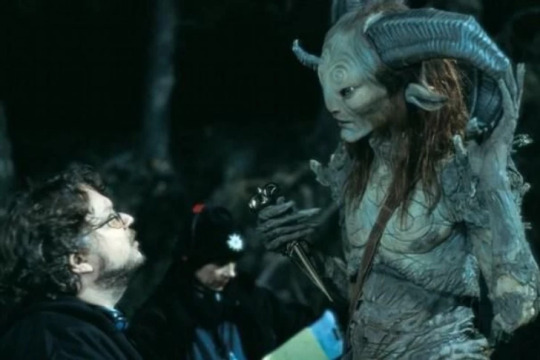
Guillermo Del Toro on set of ‘Pan’s Labyrinth’
Watching through Spanish director Guillermo Del Toro’s ‘Pan’s Labyrinth’, it’s easy to pick it up as a surrealist war piece. Yet to pick it apart in all it’s themes and glory is to delve deeper into the wonder and twisted nature of the production. The set focus on facism and womanhood does not relate, yet appear both in the war torn atmosphere that Del Toro sets up. How much can we analyse a piece of cinema? Like an English teacher breaking down how every move in classic literature has a meaning, the many facets of Del Toro’s work make it the most wondrous. The wild imagination is conveyed in the greatest sense, as visuals and communicative metaphorical devices take centrefold with Pans Labyrinth. The overdone, cutting violence can be an interruption, yet is however necessary when contrasting with the softness of one girls journey. Mind and heart, if there ever was a saying, that is how we are impacted.
With a backdrop similar to the black paintings of Fransisco Goya, like ’The Third of May 1808’ or ‘Saturn Devouring his Son’, Del Toro’s ‘Pans Labyrinth’ both enchants and frightens. Set on the backdrop of 1944 Spain, Allies have invaded and are led by the sadistic Capitan Vidal. With him is his pregnant wife and her 11 year old daughter. Fascinated with fairy-tales, young character, Ofelia, played by Ivana Baquero, encounters creatures that, to put it lightly, are not what you’d find in a classic children’s book. The mix of hideous realism and the stark nature of warfare contrasted by with the surreal escapism are elements that make Del Toro’s story wildly original. Drawing on folklore and fantasy traditions, Ivana Baquero plays ‘Ofelia’, a character who, to quote Del Toro, “saves so many things…her presence and decisions change the real world”. The grandeur and versatile components like costuming, set design, fantasy elements, effects, score, mystery, good vs evil and expert cinematography all make up the adventure tale, and with their quality, take it to new heights. Del Toro’s work stands out superbly, with Pan’s Labyrinth being one of his most notable projects, as it sticks out like a colourful and sore thumb. For something that is wired in the soul, the focus on childhood, innocence and change, all alongside somewhat familiar, yet darkly twisted fairytale creatures makes the picture.
The setting plays a great part in Ofelia’s world, as in the midst of one of the most violent wars in history, Del Toro absolutely does not stray away from this. The merciless and horrifically gory scenes can be seen as somewhat unnecessary, but all add to the visceral, cutting experience that the film provides in each element. The scars and bleeding at the start set the tone of the wickedly confronting piece. The roundedness in it and it’s two realities, both literally in the sense that it is set in a gratifying, naturalistic wood, as well as the fact that the plot line is eerily reminiscent of abusive wartime experiences. There is an escape in warfare for Ofelia, but is it really one when it can be seen as just as dangerous as war itself?

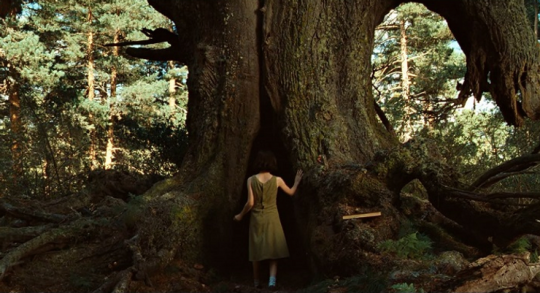
On a first watch, you may not see it, but Pan’s Labyrinth puts a remarkable point of creating striking themes that touch in on moral obedience, femininity, choices; even discussing fascism. Del Toro’s focus on these in other realms and forms of mythical creatures not only make it all the more wildly intriguing, but are equally effective in it’s ingenuity. The trials young Ofelia is put through to reach emotional and physical maturity when facing frightening creatures give her opportunity to grow, and in that, contrast the childhood of the supposed fairytales that are presented. The wondrous fantasy woodland world acts as a moral ground for Ofelia, having her make life-defying choices that eventuate in the reflection of the result of the Spanish war. This utilisation of setting is a gorgeous element of Del Toro’s work, as it combines the beauty and twisted aspect of nature, and how we are ultimately affected in it. It too shows Ofelia’s grand difference and almost appreciation of the natural world, the childlike charm and longing to explore greatly contrasts the concrete, colourless world of war.
Amongst maternal characters like her mother Carmen & housemaid, Mercedes, Ofelia is challenged and thrust into womanhood, something that Del Toro powerfully communicates with what can be said to be a feminist message. Carmen represents a repressed femininity, especially when seen with Captain Vidal, as he oppresses any such independence or voice coming from his new wife, and step-daughter, Ofelia. Sending a message of clear sexism coming from Vidal, Ofelia can be seen as acting as a replacement of her mother, or her mother’s potential as a woman. Her trials and tribulations make her just as significant as Captain Vidal. Audiences are presented with a view that as Ofelia faces life-threatening challenges in her life, like Vidal, young women are just as significant in power or meaning as a typically glorified man at war. Yet her glory lies deeper, as she clearly has stronger character and humanity in her, having her qualities, added with her circumstances, almost surprisingly rise above Vidal.


Ivana Baquero & Doug Jones in 'Pan's Labyrinth'
The strikingly infamous and frightening sequence of Ofelia with the Pale Man can be seen to so cleverly represent the fear and movement into adulthood, along with it’s deep trials and tribulations. Del Toro showcases this brutally and quite literally. The decision making that has fatal results reflects the intensity of morals and choice that Ofelia is learning, testing her disobedience and having her see it’s measures. Further to this, the comparison and contrast between the Pale Man and Vidal himself is there, as both are murderers and Ofelia does leave each to flee awful circumstances. The multiple fantasy elements add a great richness to the context of the already overwhelmingly engaging picture, a real chiaroscuro (if that exists in cinema) taking hold of many scenes. The twisted view of fairytales and enhancement of them has us seeing children’s stories and perspectives in a new and educational light. The purpose they serve is to introduce a harsh reality - Little Red Riding Hood teaching us not to trust strangers and Pinocchio teaching us to speak the truth. The mentioning of the facism of the time comes into place with Del Toro creating an algorithm to present the terror of the totalitarian leadings of Capitan Vidal and The Pale Man. Both have such eagerness to utilise violence as a means of control and to destroy human nature and free wills.
The beauty of world cinema is a genre in of itself, Pan’s Labyrinth showcasing that power and different inspiration that Spanish cinema carries. A focus on heart, family, emotion and power all overtake the impassioned Mexican directors cinematic world. Del Toro’s mix of thematic messages and intelligence on differing levels, specifically seen in the young Ofelia, given her fantastic comebacks with each harrowing ‘test’ and encounter with hell in a mythical form. The beauty and uniqueness in Pan’s Labyrinth’s surreal nature is something that so strongly sets it apart from any ordinary thriller film. The Spanish-led film has Del Toro destroying the sometimes popular notion that horror films are not interesting or award winning. The genre combinations and grand enchantment, as well as the powerhouse, raw filmmaking all add to the beauty of another touching world film.

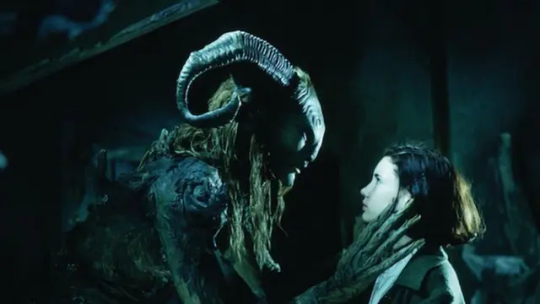
Whether or not a fan of thriller films, the truly enchanting, whimsical music that this piece of cinema carries creates the passion and significance in it. With questions unanswered, audiences can be encouraged to create their own meaning within the work of Del Toro. Yet is harmoniously affects us in both a fantastical and disturbing sense, the monsters of the woodland world following us after watching the film. That’s when you know you’re affected by a piece of cinema & it’s no wonder that ‘Pan’s Labyrinth’ has garnered such enthusiastic attention within it’s engrossing messages and stunning scenery. Since it’s release, Del Toro has blown it out of the water, winning the Academy Award for Best Director in 2018, for another one of his ultra-quirky, yet moving works ‘The Shape Of Water’. World cinema doesn’t get enough credit for it’s impact and relevance with our world today, as we can be more inclined to stick with films pouring out of Hollywood. Yet for a foreign director succeeding in Hollywood, there is a place to start. And the place to start with Del Toro really is Pan's Labyrinth.
5 notes
·
View notes
Text
A Breath Of Life In Film Stars Don’t Die in Liverpool - Review
The message of love above all facades is the strongest takeaway from this British film focused on family, hope and beauty in the unusual.
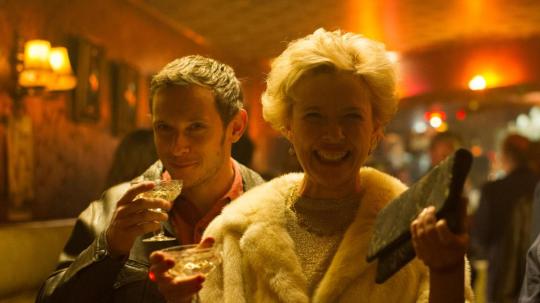
Jamie Bell & Annette Bening in ‘Film Stars Don’t Die In Liverpool’
Gloria Grahame’s glory was justified in her early days of her small town girl role in big-time classic ‘It’s A Wonderful Life’ & ‘Oklahoma!’ The retro retrospect of her is the centre of attention in Paul McGuigan’s 2017 reinvention of her later years. Based on the book by Pete Turner, ‘Film Stars Don’t Die In Liverpool’ may show that love conquers all, yet how right is it when a pair of lovers are so questionable? Fading glory turns Gloria to dust, as trouble catches up with her in the aftermath of a once bursting life. Decades following ‘Billy Elliot’, audiences are too reminded that Jamie Bell, who plays Peter, can very much dance and is a wonderful asset to McGuigan’s love letter to fame and English culture.
Warmth and tenderness in McGuigan’s unique tale takes centre force, as the focus on compassion above all is there. British films’ focus on the stripped back, sometimes cynical and rigid nature of life. And this is where the heart in them lies, as McGuigan shows no failings on this front. We are brought into what is now a former actress’ later life when moving to do theatre in Liverpool, and in next to a budding young actors flat. Once famed Gloria Grahame (Annette Bening) and newcomer, Peter Turner (Jamie Bell) already summon up a spark when meeting in the hallways of their living quarters in Primrose Hill, London. Following the years from 1979 - 1981, their unlikely friendship develops into an unlikely romance, coined as taboo, given their three decade age gap. The sweet and gentle romance is what lit her up in her final years, as her battery ran low and career was fraying at the seams. Upon grasping onto her last moments as a performer standing in the now dusty light, her attempts to remain relevant onstage in the UK in her later age don’t stand strongly. The pathos of life catches up with her, as when collapsing in her before a performance, Grahame is given the diagnosis of cancer.
Gentle and saddening, a sense of melancholy and the afterglow of what once was is everpresent in McGuigan’s take on a star that was born, but is dying. The thematic focus of this piece of cinema, and how it relates to Gloria’s camera reel running out is extraordinary, which again, British films do do best. The focus on the beauty of humanity no matter age, class, ego, meaning or painful circumstance is there. We get an inside look into a Liverpudlian household, as Gloria bunks with Peter’s family following her diagnosis. This mismatched romance is not as uncomfortable or amusing as say a characters in a film like ‘Harold & Maude’, but is rather focused on the beauty in difference. Gloria and Peter even reference and speak of playing Romeo & Juliet, as there is a Capulet and Montague complex within their love, as their age, nationality and social status completely differ. Yet, the nature of their relationship and why they connect is rarely mentioned, as occasions seem to rather occur & they instantly get on, with no such inspiration or explanation as to why.

Yet, can we call this beautiful or off-putting? McGuigan certainly does a successful job of painting it out to be more than romantic, especially for a peculiar love that should be uncomfortable and looked at from down the nose. Yet was this the true nature of Gloria Grahame? Briefly mentioned was the great controversy of Grahame’s strange relationship with her 13 year old stepson, before her affair with Peter. The silver screen sirens affair had shattered her career when the news of it was brought to the public, a decade after it’s happening. Through only touched on by McGaugin, it did have Grahame’s career pushed out of the spotlight and was a huge contributing factor to the sad burn out of the woman. Where there is beauty in the romance of two star-crossed lovers like Gloria and Peter, the reality behind the tale with reminders like this do show more of what Grahame’s twisted nature was about. Yet, it’s reasoning for simply being brushed over could be to do with the dedication to stay accurate to the setting and time of Liverpool in the late 70s. In today’s social climate, this case would absolutely have cancel culture written all over it.
Nevertheless, McGaugin seems to still perceive Grahame as a burnt out cigarette; a pitiful victim of life who still, not desperately, but noticeably clings to the glory of Old Hollywood. Where the film reel ends, Gloria doesn’t seem to. She drinks milk out of champagne flutes, takes Peter to the cinema and speaks with a Marilyn Monroe-esque tone when she overtly flirts with him right off the bat. We are treated to the aesthetics of the past, the way in which Gloria speaks on how she used to stand alongside Humphrey Bogart on the silver screen. All in all, it is a beautiful piece of cinema about cinema, as we as an audience simultaneously explore the history of film, alongside the result of one of its cherished stars.
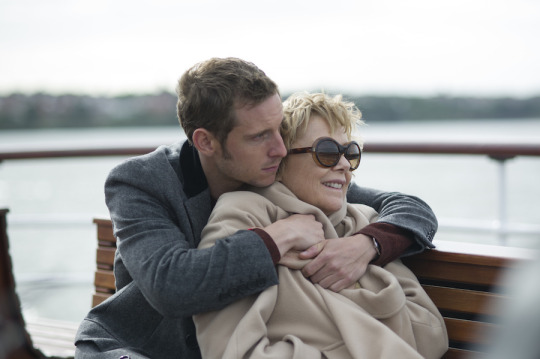
And Annette Bening herself does an incredible job of bringing pieces of strength, glimmer and beauty of hope to shine through, yet it does appear relatively corny, bombastic and one dimensional at times. Possibly the animated gestures and seductive tone was a bit much at times, yet Grahame also seemed a bit mad. Nevertheless, her performance outweighs the simple plot line. And simple the plot line is, but remains simply beautiful. As things play out, it does seem quite one dimensional. The underground, indie nature of the picture could be contributing to this, yet however much interest there was, it still could have packed more of a punch. Bening does make amends as she figuratively turns Gloria’s life into a cabaret and performance, showing how Grahame clings onto a time that is gone & cannot settle into the present. It seems that by dating young Peter, she herself is sent back into being the blonde starlet in love with her young, dashing leading man. From the opening scene, we see she hasn’t let go of the shining sparkle of the 1950s, as the opening scene has Bening opting for a Marilyn inspired makeup look, as she lights a cigarette, all the while looking into a bulb lit mirror in her dressing room. She signs a letter left for Peter with ‘xx GG’, as though it’s an autograph, and mentions the lampshade in a Los Angeles bar that has her face engraved on it as an homage to Old Hollywood.
Jamie Bell as Peter also doesn’t miss a beat, as he establishes every emotion necessary to the awkward and growing love between a couple far apart. Stephen Farber from The Hollywood Reporter quotes, ‘Jamie Bell is absolutely riveting, his most memorable performance since Billy Elliot.’ And he is great, though less exuberant than Bening, his performance as Peter shows the sensitive quietness of a local Liverpudlian seeming to struggle with his career, and somewhat leaning into hers for support and inspiration. There is never any deep delving into Peter as a person, which I thought could be interesting to the dynamic: the fact that he is a budding actor and could've had a plot line with his possible professional interest in Grahame. His normality combined with Gloria’s American cliches make for an interesting relationship, as we see the beauty of how people simply connect, no matter the circumstance.
In moments of tragedy ‘Film Stars Don’t Die In Liverpool’ does excel, with the focus on family and compassion standing out. Gloria’s divide between now disheveled and then shining shows more than ever when she breaks down during her time with cancer. McGaugin splits the emotions in half, the joyous moments come first & halfway through the film, the unexpected interruption that is Grahame’s diagnosis cuts coldly at the sunshiny atmosphere that was set up. The nature of British films is to evoke a sense of deep emotion, to which these harrowing scenes do bring, as well as showing the relationship between Peter’s family and Gloria. During her collapse and death, Peter’s family are there to support every step, showing the quirky scenario of an Old Hollywood actress in a working-class Liverpudlian household. Gloria’s death is strung out, yet necessarily so as it adds to the importance of her perspective, as she spends every waking moment denying her ageing. The montage of a miscommunication between lovers towards the latter half of the film does show some beautiful cinematography and score work, as Bening and Bell dance around their emotions with tilted camera angles, strung out violin accompaniment and solemn looks from the two.

Annette Bening in ‘Film Stars Don’t Die In Liverpool’
At it’s core, McGaugin’s interpretation of the latter years of Gloria Grahame in ’Film Stars Don’t Die In Liverpool’ is relatively strong in that it never loses it’s heart and soul. The sentiment of ‘a real actor never dies’ is carried by Bening throughout the performance of Grahame, every step and detail from her costumes to her tone or corny one-liners defining this. The message of love above all facades is the strongest takeaway from this British film focused on family, hope and beauty in the unusual.
Stars Out of Five: 3/5
visit at: dreamsofthescreen.com
#film#filmwriting#filmblogger#writersoftumblr#britishcinema#britishfilm#liverpool#jamiebell#indiecinema#undergroundfilm#gloriagrahame#1950s#modernlove
0 notes
Text
The Artistic Way of Edith Piaf - La Vie En Rose Analysis & Review
The sad starlet is portrayed so perfectly it hurts; La Vie En Rose bursts with life and emotion

Marion Cotillard in ‘La Vie En Rose’
Though there may be some critiquing of Olivier Dahan’s supposedly disordered storytelling, it is the performance of Marion Cotillard that makes ‘La Vie En Rose’ an outstanding classic. The purely harsh portrayal and music of Piaf combined with Cotillard’s more than Oscar-winning acting sets a tragically beautiful tale for a piece of world cinema. There may be a cultural divide between what non-European audiences classify as a convincing film, but as far as a French standout film goes, Piaf’s renowned biopic hits the nail on the head fourteen years later. As we are given a myriad of moments in the icons life, us as an audience are impacted, and therefore can question our position in the world. It is this inspiration that sets a film on a high pedestal, with ‘La Vie En Rose’ certainly ticking that box.
Born Edith Giovanna Gassion, she is introduced as the daughter of a busker and acrobat, soon dumped at a brothel. Abandoned by her mother and dumped on the doorstep of prostitutes by her father, the opening to Edith’s life has no glory. Yet the icon is born when she is hoaxed into performing on the sidewalk. Her father commands her to “do something”, and thus she sings a breathtaking rendition of ‘La Marseilles’. The magic of the film is highlighted in the elemental jump cuts to and from Piaf’s life. Yet the problem with ‘La Vie En Rose’ only lies in the critical response to it, as some audiences seemed to have a problem with the lack of chronological order in director Dahan’s storytelling. In an article for the Guardian, English writer Peter Bradshaw had ‘La Vie En Rose’ coined as ‘formless and weirdly selective’. Yet, I don’t find it formless or uninspiring, as these moments in time suggest the importance of memory, nostalgia and the everpresent fade of life, especially in Piaf’s. Though not as orthodox as a usual biopic, and I understand the confusion in choosing to leave out Piaf’s WWII years, yet was there really enough time to include every facet of Piaf’s life, unless Dahan were to meaninglessly speed and skim over every year of the songstresses career.

Manon Chevallier in ‘La Vie En Rose’
And sure, it didn’t show every step of Piaf’s journey, but instead opted for personal, touching and deeply tragic moments that formed Edith and her career. By delving deeper into certain moments, audiences can appreciate both the juxtaposition and contrast of showing Piaf’s early life and beaming end. As she runs through the streets of Paris in her twenties, we also simultaneously see a decrepit Edith in bed, and at death’s door. Where Dahan was to make an emotional statement to define the treacherous nature of Edith’s life, some critics found it boorish. However much the artistically cut presentation of Dahan’s story doesn’t appeal to every audience type, it is this cinematic style that positively sets it apart.
Described by American critic Richard Roeper as ‘a surreal and exhausting experience’, it can be said that selective audiences possibly found it too harsh. Yet it’s harshness is what makes it so great and so astoundingly cutting. Where American audiences found Piaf to be more intimidating than beautiful, Edith’s arrival in New York City has her reflect on this, as she says ‘Americans want beauties, not me. I’m not the Parisian bombshell they expected’. The cultural divide between what American audiences expect, not only in musicians of the 1930s, but in film today, is to have a pristine and glorified fairytale ending. The European way of looking at things is to bring some severity and realism to the table in order to fulfil the meaning and wretchedness in a true story. ‘La Vie En Rose’ is a fantastic example of just this. Yet it cut through & still soared in the United States. Winning three Academy Awards for Best Actress, Best Makeup and Hairstyling, as well as Best Costume Design, it’s success did reach international heights, inspiring audiences across the globe.
The brutality of Piaf’s journey is characterised by the endless cycle of unfortunate events. And though the title suggests positivity, the painful contrast is that Piaf’s life was far from rosy. As American’s view tales of rags to riches with as a Cinderella moment-styled turn around, Piaf’s lifetime shows us the pursuit and changes of a tortured artist. This is something that we, and foreign audiences like Americans, need to be reminded of in order to immerse ourselves into empathy and the reality of a life lived. It is the classic tale of treachery in an artists life throughout the ages - from Van Gogh to Sylvia Plath to Edith herself.

Thanks to the indisputable talents of Marion Cotillard, the sad starlet is portrayed so perfectly it hurts, having ‘La Vie En Rose’ burst with life and emotion. Richard Nilsen from Arizona Republic quotes Cotillard’s stellar performance as Edith Piaf in regards to the Academy Awards, stating “don’t bother voting. Just give the Oscar to Marion Cotillard now…her acting is the most astonishing I’ve seen in years”. And it is true, Cotillard was a scarily perfect fit for Piaf, as she tailored herself to Piaf’s throaty song and fiercely sensitive expression. There is no trace of Cotillard, as the physical transformation into Piaf is astounding. Every element of passion, pain and change is utilised to the fullest, making it the performance of a lifetime. Heart, body and soul, she is there as Edith, committing all and all to the nature of the iconic musician. Cotillard’s portrayal of Piaf’s indulgence in the finer things in life, do really equate to the classic sex, drugs, rock & roll complex of an thus, leading her into some pretty gripping dramas.
It is difficult to pick a standout scene, as in every element of the film, Cotillard exemplifies Piaf’s character. Yet there are memorable moments that define as to why she was more than deserving of a mere Academy Award. Piaf (spoiler alert) learns the news of the death of her already wedded professional boxer boyfriend, Marcel Cerdan. It is the twist of emotions, understanding of psychology and pain that Cotillard brings that makes it unlike any performance I, and many audiences had ever witnessed. This scene is entirely shot in a single take, having Cotillard act with no moment to reevaluate. As Piaf circles the lavish, yet simple accomodation in an attempt to look for Marcel’s watch & ignore any impending sense of doom, she loses it. Cotillard’s utterly devastating emotional expression transcends any language or culture, making a scene that can be defined as straightforward into one of the most heartening in film history. Followed by Cotillard’s shaking limbs and spine-chilling sobs, she is overtaken by the playing of her own impassioned music, as she glides back onto stage, signifying her return to music in times of pure distress. To say that Cotillard’s performance was overwhelming or overdramatised isn’t a vital statement, as given Piaf’s tumultuous life and harsh French attitude, she very likely was as she appears. Cotillard’s work does nothing as such to glorify or mystify Piaf, as we are presented with the continued trauma that is laced into the songbird’s life.

If we are to talk about the artistic elements of Dahan’s Piaf biopic, the mix of all departments are what contribute to the beauty of such a powerful story. The sweeping camera movements and overall cinematography choices successfully work, showing us differing perspectives of Piaf’s extraordinary life. This, combined with the Oscar-winning hair, makeup & costume, alongside the professionally beautiful and changing aesthetics throughout only make this journey a heck of a lot more captivating. We watch the remarkable mix of scenes in the final sequence of Piaf’s last moments. Dahan captures every side of a musical legends excruciating life. We see the grandeur and iconic status of Edith in her late career, wistfully singing ‘Non, je ne Regrette Rien’, along with the innocence of childhood in a young, melancholy Piaf standing in an empty field, all while next to her in her final moments, in bed and fading peacefully. The Piaf-heavy soundtrack is a great win, as the most iconic songs are played when Cotillard’s Edith performs onstage, or utilised to support the emotion in the film, blending beautifully together. Along with this, the set design is also exquisite, exuding both the decrepit nature of a young Edith’s life as a girl from the streets of Paris in the early 1930s, to the uplifted European, artistic elegance of a five-star lifestyle. We are given cultural insight into the European way of beauty - love, loss, visual arts and the rollercoaster of emotion. There is no shortage of interest or classic artistic fulfilment in each area of expression, again, only establishing such a well-rounded, cutting film with passion in every element, having it not miss a beat of creativity.
Even more in the artistic sense of film, it is how we react to and are shaped by cinema that characterises an important film. Within Dahan’s interpretation of one woman’s life, we are not only inspired, but given a philosophical approach. Though we see it as a greatly disparaging piece of film with tragedy as the main theme, there is a great deal of hope and resonant beauty in the artistic approach that Dahan takes in characterising Piaf’s gruelling life. Cotillard has Piaf appear as both doomed and reflective, her life equating to a lesson on the unexpected nature of life. Whilst we are sometimes told sentiments like ‘everything happens for a reason’, where do we step in with our faith or spirituality when there is nothing but mercilessness around a life like Edith’s? Audiences can take a step back to think about their own position; to be grateful and consider the ephemeral nature of life. We simply are given an elevated reminder of the deeply contrasting emotions and arduous nature of living. The optimism in Piaf’s music both reflects and contrasts the treachery of and deep changes in Edith’s life.
Though we have Edith sitting in beautiful rooms and attending champagne-budget dinners, surrounded by loved ones, she is still haunted by the pain and anger that was left in early childhood. Yet, at the end of the film, she sits on a beach with an interviewer, as she is asked ‘If you were to give advice to a woman, what would it be?’ to which she responds, ‘love’, & as the journalist follows up with, ‘to a child?’, she says ‘love’. Upon reflection and a life lived, Edith still has human emotion and core values left. The way of art is to portray the beauty and pathos of life, to have us question and interpret. To get to do that through entertainment is only another luxurious step up through Dahan’s haunting tale.

Heart and soul I can surely say that ‘La Vie En Rose’ is one of, if not, the most astounding biopic and piece of cinema in the history of film. The criticism doesn’t deserve credit as every available space is filled in the most, theatrical beautiful sense. As a Francophile myself, the artistic way of ‘La Vie En Rose’ is in it’s painful expression, alongside the cutting-edge work of Marion Cotillard. For a film to both enjoy the elegance of and detest the cruelty of Piaf’s existence, it’s emotion transcends many cultural barriers. Nevertheless, we are impacted within every spark and tear a tortured artist through Olivier Dahan’s winning 2007 biopic.
Stars Out Of Five: 5/5
visit at: dreamsofthescreen.com
#edithpiaf#cinema#cinemaisnotdead#writers#writersoftumblr#blogger#frenchcinema#artcinema#worldcinema#2007film#2000sfilm#aesthetics#marion cotillard
1 note
·
View note
Text
The Dust Of Bridgerton - Review
Based on Julia Quinn’s obsessively Jane Austen inspired nine novels, we as an audience step into a world laced with gossip, love and historically inaccurate details.

Regé-Jean Page & Phoebe Dynevor in 'Bridgerton'
Having audiences and the online world jump from their seats at the news of yet another romantically colourful period drama, Netflix’s 2020 Christmas release set off on a high note. However, it may not have been enough satisfaction to cover all viewers, as the overzealous series that is Bridgerton can be perceived as a cute attempt to outline high-society London, rather than a sweepingly romantic love story. From overplayed themes, to the shallow one-liners, saturated costumes and quite frankly, some controversy in a modern series, we’re not so sure that this was a 2020 release. Granted, some of the artistic involvements are wonderfully intoxicating, creating interest and having it for sure be a visual spectacle. Though, this whirlwind historical insight by creator Shonda Rhimes seemed to be a whitewashed teen-drama, instead of a maturely topical period piece.
Based on Julia Quinn’s obsessively Jane Austen inspired nine novels, we as an audience step into a world laced with gossip, love and historically inaccurate details. Set in 1813 Regency London, Rhimes’ series is a period drama surrounding the esteemed Bridgerton family, and particularly Daphne Bridgerton, the eldest daughter of the four sisters. All surrounding the pursuit and importance of finding a suitor eligible for marriage at that time, Bridgerton is the glossed over, trivial version of Pride and Prejudice. Yet there certainly still is wit, charm, enchantment and change, grabbing our attention. It is these themes that we are known to love, rather making Rhimes’ series all the more predictable and repetitive. There is beauty and moments to remember throughout, yet all in all I felt as though I was watching a weak showcase of what a mock Baz Luhrmann and Wes Anderson collaboration that exerted a blinding pastel macaron palette might look like. There isn’t really any distinguishable, first class authentic directing or writing style. We have all seen it before, which is what makes it so popular. Bridgerton’s successful reception does not seem due to the fact that it is a beautifully great show, but because of the fact that it is something written knowing that audiences will not tire of yet another stylish, skinny period drama. We have seen many renditions of Pride and Prejudice, Emma and Madame Bovary over the years, making Rhimes’ series simply another period drama that rather latches onto others for inspiration, rather than being a strong standalone piece.
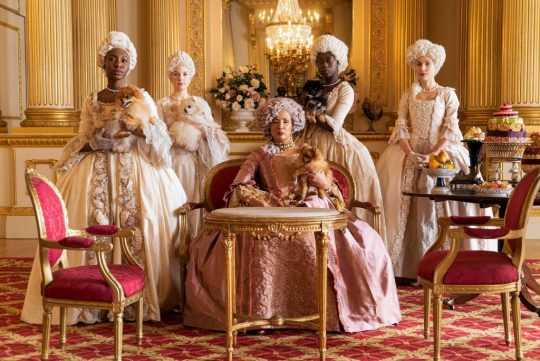
Where Downton Abbey meets Gossip Girl, some might say that this show bursts with fervour, yet it can be deemed as shallow in it’s character development and attempted strong plots. Some might say that Bridgerton has riveting grandeur, but it was films decades ago that originated it so, as we have already marvelled at the magic of the many renditions of Pride & Prejudice. And sure, there is drama, eroticism, as well as there are whispers in the streets filling the scenes of Rhimes’ take on a royal drama. But to have to create excitement by only overdoing sex and violence scenes like this doesn’t speak to highly of it’s quality. And it can be that this is what period dramas are about, yet Bridgerton’s over-embellishment of sex, drugs and rock & roll sometimes paints it out to be taking the easy way out; a cheaply written series by just landing on what is easily stimulating to audiences. As though you’re to a stand up only to have the comedian joke about porn and a night out he might’ve gone on, simply to quickly catch the audiences attention. It works, but does not hold as much substance as a joke with true wit, or in this case, a script with deep quality. The character arc’s end quickly, as does the mystery surrounding who ‘Gossip Girl’-like character Mrs Whistledown is. There isn’t much glory in the drama as there wasn’t enough of it. Yet, the focus on female empowerment and rather the female gaze was something that gets points for originality and undertaking a modern stance during the Regency time period.
Amongst the budding romance, glory and messy undertone of the series, the art department does deserve a pay raise, as there is no doubt that the costumes, set and overall work on Bridgerton make it all the more alluring. In saying alluring, it doesn’t necessary translate as the costumes being convincing. Yet the production and costume design is something that seems to define the esteemed privilege of the characters, as they dress in flashy tulle, silks and organza. Luxurious gardens, ostentatious palaces and velvet furnishings tie into the greatly pleasing aesthetics, as we are given the scoop on the Bridgerton’s drama’s, we also are taken in by their lavish lifestyles. Delicacy after delicacy in the ballroom scenes, as champagne towers flow & rich candles burn. Even in the overplayed sex scenes, velvet carpets and luxurious chaises sit on the backdrop. The combination of bountiful costumes and turns this show into an elevated treat for the eyes.
However beautiful, it can still be said that the costume & set design was just overpowering & seemed like a parody of other period drama’s aristocracy. The sickening yellow-green or floral orange gowns blinded, rather than astounded, as none of the costumes seemed entirely accurate. There are countless YouTube videos on the lack of historical accuracy in the dress. But not only are they inaccurate, they’re just unattractive. The completely saturated colours, ridiculous feathers and overall lack of style is another element that makes Bridgerton just look like a parody of that time period. Yet, cleverly enough, this may have been the point. By creating a romance-drama tale, we step into a fantasy world anyhow, so to change up the costuming can be seen as a good thing, as it does allow us to escape into it. We understand the era, but there is a twist in the aesthetic. If the intention was to accurately represent the time period, then it was far from a success. But if it was to create their own take on it, then it was an interesting move.
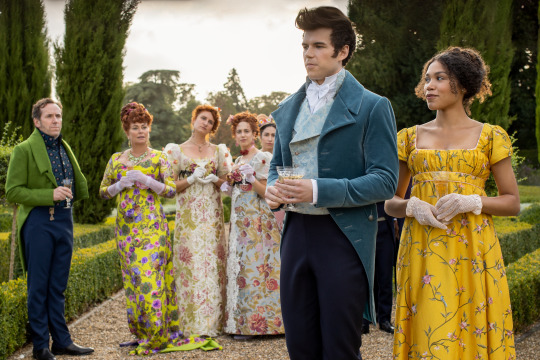
As much as Bridgerton may have looked beautiful, there were certainly bouts of controversy throughout, showing that it may not have been making the progressive impact that it may have hoped to. Rhimes’ twisted world is created & attempts to include actors from different backgrounds, but it rather plays out as just performative diversity. The only main characters of colour are a light-skinned bi-racial man & a snooty looking Asian queen. Obviously and unfortunately historically inaccurate to 1813 London whatsoever, this pursuit to be progressive was admirable, but rather stuck out like a sore thumb & did not blend naturally or seem at all organic. This is because it more so seemed that characters of colour were rather sprinkled in the background with no definitive lines or moments, making even the inclusion of them quite ironic, as it was not fully inclusive, for a show that may have claimed to be diverse. In saying this, of course, along with the blinding costumes and sometimes plastic-like set design, Rhimes’ had created a fantasy version of 1813 London, yet still was unable to do it justice. Colour and race were apart of Bridgerton, but only comfortably and what is suited to the media.
As stringed instrumentals playing Taylor Swift’s ‘Wildest Dreams’ or Billie Eilish’s ‘Bad Guy’, a make a modern take on classical music is made, this change much like the series itself. Whether or not Bridgerton was entirely convincing, it surely still was entertaining amongst all it’s inaccuracy or shallow writing. As to why it was renewed for three further seasons with Netflix, we are not sure. The colour and pompous nature of the series does grab our eye, but cannot hold it for too long, as we may see ourselves comparing it to any other period drama we previously loved. Shonda Rhimes’ ‘Bridgerton’ succeeded in becoming a household name on Netflix, thoroughly captivating and charming, it is a good teen-based and glossed over period piece. When it comes down to good filmmaking with Rhimes’ adaptation of the sprawling novels that Julia Quinn wrote, it really wasn’t all there.
Stars Out of Five: 2.5/5
visit at: dreamsofthescreen.com
#bridgerton#shonda rhimes#phoebe dynevor#costume design#netflix#writersoftumblr#writer#blogger#cinemaisnotdead
2 notes
·
View notes
Text
The BBC’s Take On Greta Thunberg - A Year To Change The World Review & Analysis
“I don’t want you to listen to me, I want you to listen to the science”.

Where the world needs a leader, the general image is not an introverted 18 year old Swedish girl discussing the burning topic of climate change. Yet internationally known environmental activist Greta Thunberg has taken the world by storm, her recent journey being followed on BBC’s ‘A Year To Change The World’. With Thunberg as the star, we follow more than just her life in the limelight, but the grand science behind the work that she so elegantly does. Speaking on the devastating effects that climate change has, we are not only given valuable information, we are so emotionally moved by the composition of and meaning behind Thunberg’s gruelling fight for climate justice. As an audience, we are presented with facts that have us question our place and responsibility as human beings in our ever-changing, endangered world. Where documentaries give insight into an icon’s life and legacy, Greta Thunberg’s ‘A Year To Change The World’, gives us an outstanding message on the urgency of the present moment that we have to protect this earth, making it all the more beautifully affecting and involved with our society.
‘Greta Thunberg: A Year To Change The World’ has the BBC follow Greta’s ventures over the last couple of years across three episodes. Filmed on location across North America & Europe, we see Thunberg walking across glaciers, through Canadian rockies, into power plants and climate conferences. The BBC so greatly touch on events that show such great relevance to popular society today. What makes a documentary so great is it’s ability to educate and change it’s viewers. And change is the goal with the showing of this series. We are given insight into the personal affects of natural disasters, like the 2018 Californian Wildfires that killed 85, not only hearing from the victims themselves, but hearing Thunberg explain the heartbreaking science behind an event that is usually just seen as another news item. To see the upfront, raw emotion from a resident from Paradise conveys how serious matters were. The facts that go along with the devastation of the wildfire pushes us as an audience to look at where we stand. As in scenes like this accompanied by Greta, we see just how many lost everything & really had been driven to the point of suicide due to the fires, creating a personal moment. Yet, where there is this truth and emotion, there is a snarky politician, in this case 45th President Donald Trump who brushed the fires off as a result of ‘poor forest management’. These comparisons have the impact to frustrate audiences, getting them to so clearly form an understanding of the severity of our world at threat, rather than just showing the glorified version of Greta’s work or fame. It is raw. And Thunberg says it herself best, touching on natural disasters by stating, “we see all these things repeating themselves over and over again, people die and people suffer from it, but we completely fail to connect the dots”.

Greta again and again speaks with countless scientists, workers and politicians across the globe on the climate crisis. From meeting them at power plants to Scandinavian border crossings, parliament houses and national parks, we are endlessly thrown pieces of information that we cannot miss or deny. We so easily see the scale of the problem at hand in dire need of assistance today. The series itself is a bit predictable at times, with Thunberg sat in a warehouse-like studio, explaining her mission & meaning behind her work. Unless you are a complete novice to ever having heard of the name Greta Thunberg, then a fair bit of what she speaks about has been said before on most news items on her. Yet it hardly lessens the impact of the series, as it still stands strong, due to the fact that it is the science that is the key focus, rather than only Greta herself. Something that makes this series less self indulged & more for the audience to be educated is this matter. But this gives it such quality, instead of a glossed over narrative of a celebrities life.
Greta herself had stated that the motivation behind the project was to “give science a voice and to really go more in depth” and for the series to “make a lasting impact”. And indeed it mostly does, the camera following Greta not only just documents her ventures, but delves into the emotional impact that her work has on the world and herself. This is what makes a strong feature - one that so surely impacts an audience. As we are shown images of the worldwide protests that Thunberg’s ‘Friday’s For Future’ sparked enormously, we are all the more inspired. She speaks on her childhood and how, through discovering the disastrous affects of climate change, she was severely depressed. Yet her ambition to fight climate justice, and succeeding to the greatest amount is another element the documentary that shows Thunberg’s ambition and beautiful determination to fearlessly continue fighting for the one thing she believes is so paramountly right. No doubt that Thunberg does not enjoy the spotlight put on her, but it is her mission at hand that she is focusing on, despite the load of hate and discrimination thrown at her. Cameras click and Thunberg is almost worshipped by her followers, yet this is not what she is about. She makes it clear that it isn’t about her, the opening of each episode showing Thunberg stating, “I don’t want you to listen to me. I want you to listen to the science”.

And the science is right. The BBC so eloquently explores many facets of the areas in our world that impact the climate the most, showing Thunberg touching on the impact of flying, materialism and the food industry. As a former vegan, I remember it was the documentaries that changed my life. Watching features like Earthlings and Cowspiracy completely shifted my view on our world. Not only Thunberg’s mentioning of things we can do to reduce our carbon footprint, but how important it is to do so is what packs such a punch. We see the reasons behind why Thunberg has chosen to stop shopping, take up a meat & dairy free diet, as well as suspending all air travel, as they all amount to the toxic pollution and mass-consumerism that our society emits. Greta focuses on these topics & asks familiar faces how things may have changed throughout the years. One of these familiar faces was Sir David Attenborough. As he and Greta meet in the London, it is this touching moment that we see two icons discuss something so topical that grabs audiences attention easily. It is clear how important this issue is to the both of them, Thunberg’s twisting facial expressions already telling us so much. These moments do make ‘A Year To Change The World’ so very provoking, as viewers do know and love popular personalities. Emotional moments are conveyed strongly, as Episode 1 ends with Greta returning home to Stockholm for Christmas after 134 days of travel and campaigning. Backed by a celestial rendition of ‘Silent Night’, Thunberg speaks on the grand importance of hope, whilst she is captured emotionally returning home to her dogs and familiarity, showing a sense of her normality. It is in these moments that we too see another side to Thunberg.
While we don’t learn entirely new things about Gretas fight for the climate, we do somewhat delve into her as a person, not only seeing just how iconic she has become, but why she needed to be a voice for our generation. Thunberg states that “my favourite story growing up was the emperors new clothes. the emperor is naked & everyone just pretends he isn’t. the only one who dares to question this collective lie is a child.” Thunberg’s young age is something that has been attacked tirelessly, news reporters labelling her as ‘naive’. But her ambition and blunt passion for her work makes he soar above others at times. Where many are afraid to speak out, Thunberg is known for doing just that. Some paint a picture of Greta as a youngster who battles it out with politicians in heated debates on the climate crisis. But it is hardly that, as her wisdom and emotional maturity has her soaring over politicians in terms of the ambition to just get things done. Thunberg has no fear in revealing that politicians like prime-minister Angela Merkel has summarised the fact that the German government’s ideals weren’t lining up with the Paris Agreement, as they were supposedly assured to be. Any opportunity she can, she shuts down any politicians’ misleading promises and repetitive rhetoric. Thunberg’s strong-willed nature contrasts many world leaders, showcasing her growing power, making her character and work simply inspiring across all generations. Her resilience and devotion to her craft is gracefully documented, making ‘A Year To Change The World’ a feature that does mostly delve into parts of Greta’s psyche.

As the BBC closes out the 3 episode journey of the most distinguished climate activist with a roar of stringed instruments and comments from scientists on the urgency of our moment now and to stop ignoring the facts, we see the numbers firsthand. As global temperatures are to rise by 2-3 degrees celcius by the end of this century, this may not seem like a lot to us now, but with empathy, we must see how detrimental it is to the future. As Thunberg time and time again sounds the alarm in an attempt to wake up our society on the pressing need for us to change our ways in order to save our only home - earth. ‘Greta Thunberg: A Year to Change The World’ is one of those features that has great potential, which it successfully meets. Sure, there is always room for improvement and further depth, but if we take a look at a single series and are able to step back & see ourselves in the grand scheme of things, amongst all the noise, then a great documentary-series has been made.
Stars Out of Five: 4/5
visit at: dreamsofthescreen.com
#gretathunberg#writer#writersoftumblr#bbcearth#writing#documentary#climatechangeisreal#climatechange#environmentalism#2021
0 notes
Text
Alluring or Meaningless? - The Ending of Sorrentino’s La Grande Bellezza (The Great Beauty)
Renowned director Paolo Sorrentino's classic 'La Grand Bellezza' mixes the pathos of life with philosophical ideas, but does its ending even have the desired meaning that audiences were expecting?

Giusi Merli in ‘La Grande Bellezza’
Paolo Sorrentino’s renowned 2013 Italian modern classic, ‘La Grande Bellezza’ (The Great Beauty) was certainly one for the critics to praise highly, yet there is a certain quality to its largely masterful storytelling that can see it lacking in true depth. Where much of the film’s entirety soars, its value seems to get lost amongst its artsy attempt to create meaning, where it really can appear as overdone and quite hollow. If we look at the last 30 minutes of Sorrentino’s work, we as an audience can certainly debate whether there is awe-inspiring significance or just overplayed rhetoric in the ending of La Grand Bellezza. Where whimsical characters and moments are introduced, viewers can be very easily swept up in Sorrentino’s foreign fairytale, where it really can be deemed as just pretentious. Yet, this point is far from black and white, as ‘La Grande Bellezza’s’ meaning is up to the audience to interpret, still making it a favoured and beloved work.
Italian director Paolo Sorrentino’s works have garnered praise for their dramatic and striking visuals, as well as their convoluted plots. He has been compared to Federico Fellini, and certainly does seem to take inspiration from the 1960s film icon. But Sorrentino is certainly no copy of Fellini, as his culturally inspired films do reach audiences well. Yet where The Academy Awards gave it the win for Best Foreign Language Film, and where critics seem to kiss it’s feet, this doesn’t always mean that it is altogether an expert piece of cinema. You can say that the beauty of film is that it can be totally subjective, which, in hand, is what makes such great art. So us as an audience can ask whether we view the film as more so pretentious or philosophical?
‘La Grande Bellezza’ follows former writer & popular socialite Jep Gambardella, a sort of philosophical muse for Sorrentino. As Jep’s life in Rome is consumed by materialism, it isn’t until his 65th birthday that he begins to look inwards. This leads him on a search for ‘the great beauty’, which has him relishing in nostalgia and existential simplicity, audiences closely following behind on that journey with him. The greater part of Sorrentino’s film does successfully have us questioning our place in the world, and where our values lie. Through comparing and contrasting the superficial high life with what’s most important to humanity, we are reminded of our own perspectives on what does and should hold the most substance or meaning.
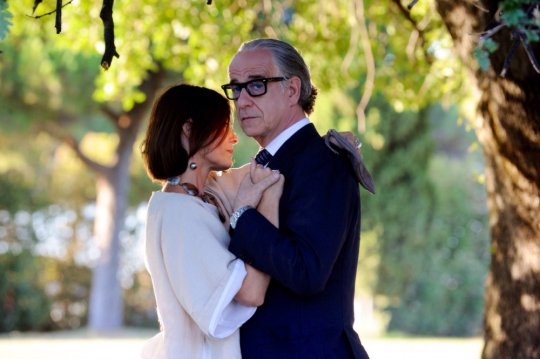
Toni Servillo in 'La Grande Bellezza'
Yet as Jep has wandered around searching in different areas for beauty in truth and philosophy, his defining moment seems to be towards the end of the film, when he is introduced to Saint, Sister Maria. As Jep is told that she had ‘read his novel & loved it’ years before, we are left open to interpretation to who this Saint may be. Yet the answer in itself is somewhat disappointing. Again, it is not to say that the ending of Sorrentino’s film is wrong or terrible, but is surely very thought provoking.
This moment starts in the last thirty minutes of the film, and we are never given a backstory to Sister Maria when or before she is introduced. And she is introduced, literally, on a pedestal. As she sits there in silence, she wears a dusty, grey-blue nun’s habit, her olive skin lined with deep wrinkles, and expression truly dried out. Members of high society kneel to her, kissing her hands. In the chapel that she sits, there are priests, monks, African tribesmen and all in all, only established figures flocking to her, their eyes wide in honour of her presence. It is as though these figures are all awaiting an answer that they cannot find, and seek out from Maria. Though she is established as a wise old prophet with supposed life-changing aid, what makes her so respectable? She appears as though she has lived three lifetimes and has ‘only granted three interviews in all her life’, yet this alleged messiah altogether utters very little meaning. Sister Maria’s introduction has her appearing as a monumental figure, mostly due to the filmmaking aspects of the scene. In the chapel, lit with a chiaroscuro inspired light, along with medieval Roman Catholic music echoing throughout, with the purpose of warming our hearts. Contemplative looks from across the room, including a black priest, may be there to show the diversity that Maria is surrounded by, as those across the globe seem to adore her. The only interpretation gathered is that Sister Maria is an attempt to create a grandiose moment to close out the film in a profound sense. Yet what I’d gathered of this Saint, is that she lives so austerely that Sorrentino’s ending becomes muddled and pretentious.
As previously mentioned, we are never given a backstory to Sister Maria, but maybe that is the beauty of it that Sorrentino was trying to portray. This icon in the film is looked up to for her granted simplicity. But by portraying something so obscure, Sorrentino’s work doesn’t always appear as interesting, but as an attempt to do so. Is it her goodness or her stripped back way of living that those aspire to? And why does it need to be members of high society that only seek her advice? Wouldn’t Sorrentino’s inclusion of ordinary citizens make it all the more realistic, or relatable and grounded, rather than once again getting caught up in something so grand?
Her grandeur is never explained, to which we can be inspired or simply baffled by the mystery, seeing it as something that creates interest, or just remains pretentious. Yet even if her significance was explained, and made this supposed icon as meaningful as someone like the Pope or Mother Teresa, aren’t we supposed to be inspired by the ordinary and the beauty in simplicity. Isn't the point of 'La Grande Bellezza' to celebrate the simple things in life, rather than an established, worshipped figure? The portrayal of this kooky character tries to make a point towards being so well grounded, that it is absurd. As she speaks to Jep, she asks 'Do you know why I only eat roots?', to which Jep asks why, her response following as, 'Because roots are important'. Now Sister Maria's actions line up with her values and grounded nature, as she genuinely decides to eat roots. This can be seen by some as profoundly inspiring, but is altogether quite a weak attempt to deliver an overly-artistic message. And sure, it isn't all pompous, as there is a great reference to the Catholic influences in Italy and the holy hierarchy of Rome & it’s art. But it is the aureate expression doesn’t sell it as being moving, but is instead simply too showy.
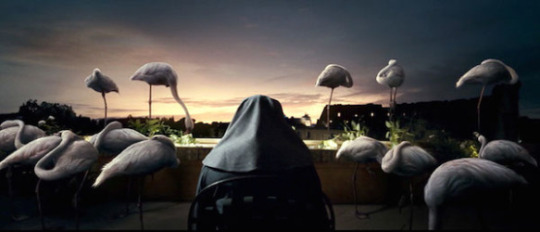
When sat down at dinner with Jep and his fellow members of Roman high society, Maria is slouching at the head of the table with a vapid expression. The attempt at meaning that Sorrentino has so clearly tried to create is open to interpretation, yet it can be said that this is not one of the his finest writing moments. Sister Maria does not speak a word, and whenever she does, it is a brooding comment that is supposed to hold substance, but instead can be regarded as pretentious. The moment she lifts her head to comment on Jep's novel, all eyes are so enthusiastically on her. Sister Maria does not sleep in a bed, as she finds Rome’s 5 star Hassler hotel, ‘uncomfortable’. Her perspective on life can be seen as purely existential and somewhat nihilistic, or greatly generous. As she works alongside the sick and supports the Third World, her abandonment of any enjoyment and subscription to poverty has us question our place. Is someone really so empathetic that they’ll refuse any comfort, because others are worse off? Again, Sorrentino does succeed in communicating a message that has us asking questions like this, yet the point is too greatly emphasised through the worshipping and dramatically overdone expression of this holy character.
As Jep focuses on switching his hedonism for eudaemonism, his perspective on the finer things in life is the things he used to have, leading him to relish in nostalgia. Sister Maria seems to be an exaggerated symbol of his changing philosophy, as well as a turning point for him to once again write, after abandoning any such creativity for decades.
Something in meeting Sister Maria has Jep retuning to Giglio Island to report on a shipwreck, again, quite symbolic of Jep’s career position, having not written a novel in 40 years. Here, he remembers his first meeting with his first love, to which inspires him to write again. Apparently Sister Maria is the bridge between Jep’s despair & newfound hope.
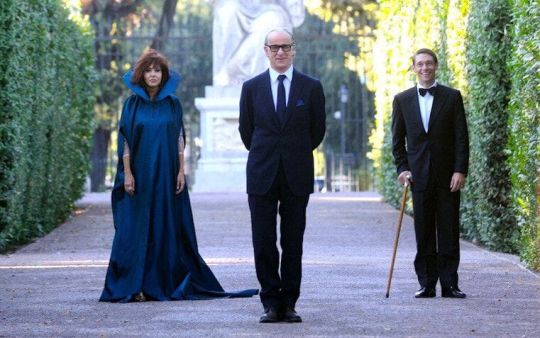
Paolo Sorrentino's expertly expressive film is a no doubt a masterful passion project that communicates the pathos and joy of the human condition, impacting audiences greatly. Yet Sorrentino's attempt to create something meaningful to close out an already wonderful film filled it with more vanity than it needed. It is an entirely subjective work that involves the audiences thought and we can all interpret it how we see it, which is assuredly a good thing. However, Sorrentino’s quite bombastic ending was just a questionable cliffhanger and didn't line up with the greatness that the first two hours of 'La Grande Bellezza' provided. Though a fantastic feature, Paolo Sorrentino seemed to get too lost in portraying a message so obscurely overdone, that it had somewhat lost it's original meaning.
visit at: dreamsofthescreen.com
#cinema#writer#blogger#bloggersoftumblr#italianfilm#philosophy#cinemaisnotdead#cinematography#worldcinema#italiancinema#la grande bellezza
3 notes
·
View notes
Text
The Debate On Life in La Grand Bellezza (The Great Beauty) - Analysis and Review
“Traveling is very useful: it makes your imagination work. Everything else is just disappointment and trouble. Our journey is entirely imaginary, which is its strength.”

Toni Servillo in ‘La Grande Bellezza’
Nominated for the Palme d’Or at the Cannes Film Festival, Paolo Sorrentino’s ‘La Grande Bellezza’ (The Great Beauty) can be seen as a stroke of real cinematic magic. Though blunt and simple it’s premise may appear, the Italian art-drama film mostly flourishes in it’s ability to communicate a profoundly deep and educational message on humanity today. And however much of a visual spectacle that it is, it is the change in one man’s lifestyle from decadently hedonistic to lavishly inspiring sweeps us off our feet, the romance of Rome following close behind. Direction by Sorrentino and cinematography by Luca Bigazzi, this work is seeped in richness and pure emotion, leaving many critics weak at the knees. Sprinkled with history and following a poetic undertone, the opening scene quotes Celine, stating “Traveling is very useful: it makes your imagination work. Everything else is just disappointment and trouble. Our journey is entirely imaginary, which is its strength.”
Set amongst the grandeur of the eternal city, Rome, we follow Jep Gambardella - a 65 year old acclaimed former writer and socialite who lives and breathes the superficial high life. It isn’t until after his lavishly outrageous 65th birthday party that he looks past the nightclubs to look inwards and find true meaning or ‘the great beauty’. Amongst all the frivolous glory that sex, drugs and rock & roll seem to provide, Jep is searching for truth. No doubt a shockingly stunning film that can be compared to the likes of European classics, Federico Fellini or Jean-Luc Godard, Bigazzi’s cinematography tends to focus on architectural pieces, bodies and classical art, thus following the culture of Rome closely. Appearing as though audiences follow the camera themselves, some of Jep’s closest friends are seen through freely moving shots, sometimes frantically following the beat of the pulsing club music. Flowing with history, operatic passion and grand emotion, some claim that it is the visual spectacle that creates the meaning of the film, rather than the meaning itself being striking. Yet, it is the mix of visuals, plot and the great characterisation of Jep as a person, as well as his change that creates the grand interest. From technicolour rooftop nightclubs to the silent streets of the eternal city, we get differing perspectives on modern Rome, and how it blends in with it’s ancient history. Sorrentino summed up the location in all it’s grandeur by stating ‘Rome has a beauty so large that one could die from looking at it for too long’. And Sorrentino seems to even portray Jep as the human embodiment of Rome, as he lives through the city’s highs and lows. I will say that, however much Jep seeks to find ‘the great beauty’, he is still surrounded by luxurious interiors and grand Roman palaces, not exactly aligning with his growing ideals and change in attitude. As if to make a point of his attempted normality and stripping of decadence, he still walks among it many times. Yet these environments do turn into something simple like a local coffee shop or a siesta in his apartment, thus showing his change.

Often compared to Fellini’s ‘La Dolce Vita’ because of it’s similar plot, Sorrentino’s film certainly seems inspired by that, but is not just a carbon copy of it. It does stand strongly on it’s own. ‘La Grande Bellezza’ seems to be a deeper character study of Jep. There is analysis in the plot, and there is the contrast between life and death, as well as the grandeur of simplicity & nostalgia. Where Jep fits in as a real socialite, mingling with other members of high Roman society, he is the standalone character who really looks within himself, rather than only around. And the film captures a generation caught up in facades, who do refuse to look inward. Struck by the death of a lover from the past, where Jep was once running around in fame and nightlife, he is motivated to look back on simplicity, rather than the excessive. This simplicity comes in appreciating the natural beauty and culture of Rome, swapping a strip club for a quiet afternoon in a historic vineyard or museum, reminiscing on his childhood. As someone asks Jep “what is it that you love the most?”, he responds with, “the smell of old people’s houses”, commenting on something so simplistic, but still beautiful in it’s age and nostalgia. This nostalgia beckons Jep following the death of Elisa, his first and only love. However romantic this may seem, it is more so philosophical in it’s approach. Searching for more meaning, having now reached 65, he however does at times seem more pessimistic as he looks into himself, stating ‘what’s wrong with feeling nostalgic? It’s the only distraction left for those who’ve no faith in the future’. Us as an audience can view this as either something quite pretentious and negative, or interpret it as a step towards appreciating what he once had, and can work towards.
And the film itself is at times quite pretentious, but it is floating around in philosophy, and still for sure packs a punch. The philosophy is in the ever-changing time and focus on nostalgia. In a scene where Jep ends up in a plastic surgeons office, he is surrounded by old hopefuls who long for their past & get it through pricey facelifts. A scene focusing on nostalgia, the surgeon asks the woman, ‘want to go back 30 years, to when it always rained in late August?’ The bell rings, calling customers again and again, this showing the repetitive and lifeless nature of these creatures desperate for the past, with no regard for their own happiness, but have decided to instead conform. Jep often has these moments of recognising and looking past this fakery, once the curtain of his lavish lifestyle drops. In terms of Jep’s change, there is the contrast between life and death, and having reached the age of 65, some cynicism is there, but it is all a grand reflection upon his own changing desires. The change from being the king of high society to settling down as he goes through life could be seen as just an exaggerated view on what happens as we grow older, but 'La Grande Bellezza’ strategically claims it to be more than that. Set in the eternal city, Jep sees the ephemeral nature of most things. Where there is celebration of life in parties, there is also tragic death, having those festivities seem pointless. He states, ‘this is how it always ends. With death. But first there was life.’ Pointing in the direction of existentialism, this is a fairly simple statement in the blunt writing of Sorrentino, but sums up Jep’s perspective quite successfully. Where death happens every day, the eternal city that is Rome continues to go on, it being a playground for those in it during their time.

Like exchanging a stack of cash for a chocolate gelato, the debate about what is most beautiful in life is subjective, but mostly easy to answer. This being love, family, cherished moments and happiness. Sorrentino’s film creates such a contrast between two great beauty’s, focusing on the lightheartedness and meaninglessness of life as something so grand, as opposed to the glamorous and superficial. This fairly simple point is communicated with wonderful execution, gripping audiences onto every moment and person that Jep encounters. The writing style and expression of the film itself is quite blunt, yet I so appreciated this & found that it only kept it more realistic. Seemingly straightforward in it’s approach, this bluntness did mean that emotions don’t flow as freely you’d expect and are not visibly fluctuating or dramatised.
Something important to note is that Sorrentino’s film is not only a comment on one mans story, but of course society today. He may have been trying to paint a picture of the differing perspectives of modern Italians, a take on modernity that anyone abroad can relate to and understand. Though to say that Italians are either loudly materialistic or quietly philosophical is an exaggerated view of the two extremes, rather than a summation of all Italian culture. Sorrentino too so cleverly comments on the history of Rome in a beautiful way, as he shows the change in and disregard for Rome’s epic culture. For someone like Jep who writes about the light and life that Rome offers, he hadn’t written a single thing in 40 years, pleading ignorance to these cultural writings, as he got caught up in the generic party scene. Rome seems to be the perfect place and most definitely not just a pretty setting, but a backdrop to represent the need for Jep to find himself again.

As modernity and the party scene greatly contrasts the beautiful history of Rome, Jep, though the ‘king of the highlife’, finds himself and ‘the great beauty’ whilst focusing on the historical beauty of the city. This could be as though to say that he went back to what was always there, after decades of relishing in the fakery of high society. This is a point familiar to many, that money or fame cannot buy happiness or love, and that the novelty of it does wear away for good reason. And this is a popular debate, as we as an audience can comment on what we find most beautiful, challenging us to question our place in the world & whether or not we should rely so much on ephemeral materialism. Following his revelation of change within himself following his birthday, he states that ‘the most important thing I discovered a few days after turning 65 is that I can’t waste any more time doing things I don’t want to do.’ Whilst he sits down to drinks with members of Italian aristocracy and engages in meaningless affairs over the years, none of that was what he wanted to do.
Jep’s mission to find the ‘great beauty’ stems from not only the shock of the death of his only love, but the fact that he has an unfulfilled career goal. He had wanted to make a film about ‘happiness & how difficult it is facing the passing of time’. To which, whilst at another seating with Italy’s cream of society, friend Gustave Flaubert comments, ‘the finest works are those that contain the least matter; the closer expression comes to thought’. Again, Jep is searching for meaning and passion, but this focus on nothing is greatly existential.
And the film itself is a bit pretentious at times, as much as critics do drool over it, as it could be noted as a European wonder, as it’s expression is quite different to any classic British or American feature. Sorrentino seems to attempt to make a big point about the fragility and fleeting nature of life, yet it is hard to ravel. Maybe tedious, it does still make an excellent point and, marking what makes a terrific film, it does still have us audiences in deep thought. Is the poetic and philosophical nature of Sorrentino’s writing provoking, or just confusing? As Jep is surrounded by hopeful authors, brooding thoughts tossed around in an attempt to create some depth. Yet these statements that seek to inspire can be deemed as only artsy and somewhat overblown. Though it is absolutely not without it’s great moments of reflection. As Jep visits a friends’ wedding, he tries to engage in a meaningful conversation with a priest, who instead fobs him off as he becomes distracted with the gossip and scene around him. This is a moment that is impactful, as it presents the grand change in society and even how established figures, such as a priest, have become caught up in the popular bustle of daily life, rather than their deep-seated faith or thoughtful meaning.

Sorrentino’s master work that is ‘La Grande Bellezza’ (The Great Beauty), is critically acclaimed for good reason, as within it’s gorgeous colour, life and grand visual spectacle, there is still a beautifully resonant message. A film or piece of art’s interest can be defined by it’s discussion, as Sorrentino does successfully get this ball rolling. The film so successfully does capture a society who refused to collectively look inward, to which audiences are vastly inspired in all it’s philosophical questioning. Though it can be deemed as a grandiose piece of work, it is still nothing short of exceptional, and does deserve the majority of the praise it has received over the years. As travel is an aspect in life that educates and changes us, Sorrentino’s ‘La Grand Bellezza’ is like a walk through Rome that has the potential to immeasurably shape us, making it one for the books.
Stars Out Of Five: 3.5/5
visit at: dreamsofthescreen.com
#cinema#italiancinema#paolo sorrentino#italianfilm#film#filmwriting#filmwriters#writersoftumblr#blogger#philosophy
2 notes
·
View notes
Text
Stanley Donen’s Marvel At Love - Two For The Road Review & Analysis
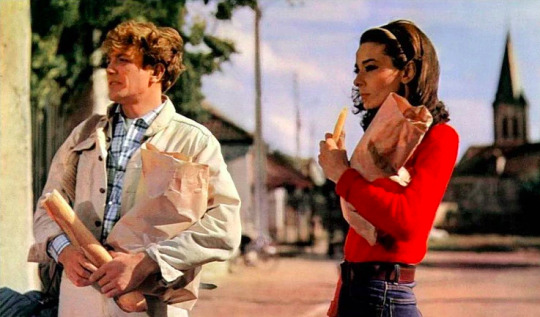
Albert Finney & Audrey Hepburn in ‘Two For The Road’
As far as romance goes, in the era of classics, we are given a idealised and soft edged view on a what love is or could be. Stanley Donen’s ‘Two For The Road’ appeals in it’s quirky and realistically sharp depiction of a marriage, as the beloved Audrey Hepburn and renowned film star Albert Finney ‘make something wonderful out of being alive’, as the trailer depicts. Driving cross country through France, we follow the unravelling of a decade long relationship, having us along for the ride & analysing the highs and lows of love. The simplicity of a love story with no certain grandeur is the greatest excitement, as room for interest is in the writing and expression of the story itself. A catalogue of successful retro arthouse, colour-blocked aesthetic films, Donen’s 1967 love story combined with Frederic Raphael’s blunt writing style delivers a versatile and greatly entertaining tale of love lost and found.
Joanna (Audrey Hepburn) and Mark (Albert Finney) have been married for a decade, and are now establishing their rocky connections. Travelling from London to the South Of France on a work trip related to Mark’s architectural career, they unpack the highs and lows of their relationship, reestablishing where they’re at now, and ultimately going back to how much they do need each other. Finney and Hepburn hitchhike, drive and fly around France, as we follow the couple in all their quirks, romantic moments and complications. The entire film is like a diary of their relationship, based on their travels in France throughout the years. Frederic Raphael’s award winning writing captures the moments that come with being in love, like striking grief and pure elation, set on the backdrop of the stunning French countryside. Their adventures have them repeatedly joking about Mark’s tendency to misplace his passport, finding themselves abandoned in the rain & having to sleep in a concrete cylinder on a moving truck, as well as Mark falling clumsily into a pool when trying to chase after Joanna.
Flashing back between Joanna and Mark’s early days of marriage, to their downfall that had them engaging in extramarital affairs, the grandeur and pathos of love that is portrayed was not usual for films at this time. Made in 1967, honest emotion like this was only starting to break out in cinema, as the Production Code (dictated what could be shown or said in film), was changing. For audiences, we are given insight into the pure joy and heartache in a couple that, despite their changing dynamics and hostility to one another, do still truly belong to each other. By combining a comedy with romance, drama and even some philosophical commentary, some may argue that this, along with the constant jump-cuts, is too much at once for a film. Yet I believe that it creates powerful interest, taking audiences on a journey that is tastefully stylish and does not overwhelm us too much.
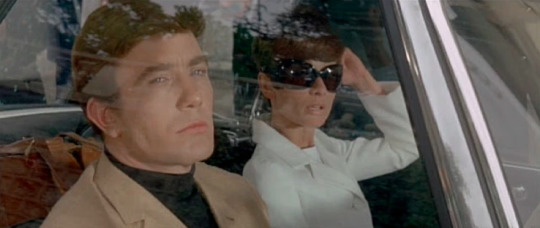
Stanley Donen is not shy of success, having directed ‘Singin In The Rain’, ‘Charade’ and ‘Funny Face’, making ‘Two For The Road’ a rather less heard of film of his. His films were technicolored with soul and charm, almost seeming to follow a New Wave style. Once films started using colour, especially in the 1960s, it became one of the main assets, bringing great life and joy to a movie, Two For The Road doing just this. Though an American director, his works are never seeped in Hollywood-fakery or predictable cliche’s, as they seem to follow a more natural style, this honesty being so important to the depiction of a marriage like Joanna & Mark’s. The Los Angeles Times wrote on his directing style, stating that he ‘brought wit, style, heartache and joy to the movies’ and too asked, ‘What does pure joy look like on screen? Stanley Donen gave us no shortage of possible answers’. With the beautifully sweeping and romantic soundtrack by Henry Mancini and Donen utilising jump cuts between different time periods, ‘Two For The Road’ really does follow the art-nouveau, French New Wave style of cinema. This has Donen stray away from the typical process of an American director, ultimately saving the film from becoming a corny, glamourised love story. The pain, happiness and change is what makes this story so widely romantic, as it follows something so uniquely realistic.
This, along with Frederic Raphael’s lyrically raw and amusing writing creates an honest interpretation of a relationship that we can either relate to or know about, given the tenderness and change of a love barely standing. But Donen and Raphael don’t just have audiences follow Mark and Joanna. We are given an analytical look at their time together, delving into how they fall in love, what changes after getting married and having a child, time changing their dynamic. We see how a marriage turns sour, it’s charm wearing away as Finney and Hepburn are left with a child, and a love gone cold. The opening scene has Hepburn and Finney stylishly pulling up in their car, passing a wedding, Hepburn stating “They don’t look very happy”, to which Finney replies, “Why should they? They just got married”.
Of all of Audrey Hepburn’s doe-eyed, elegance-seeped roles that she is so well known and loved for, Stanley Donen shows her in a beautiful new light, her performance soaring. It can be argued that ‘Two For The Road’ is one of her strongest roles. As an avid Hepburn fan myself, it is the freedom that she is given within the character that adds edge and interest, as opposed to the doll-faced, girly performances of hers that are beautiful, but can be shallow. This was a real change for her, as she drops the classic black Givenchy dress for a colourful, more casual wardrobe. This only made me fall in love with her more, as she is involved in a comedic and rich performance, creating such layers to her, as well as really exuding her acting talents as she steps out of her comfort zone. This is also a more realistic Hepburn, as the role is even closer to herself as a person, as during filming she was going through the beginning of a divorce. You’d hope that this is what Donen had been meaning to succeed, by showing such a beloved icon in one of his films. Albert Finney was a match made in heaven for Hepburn in this film, as their chemistry is electric, making something so basic seem so wonderful or painful. As the trailer itself states, we watch ‘Audrey Hepburn and Albert Finney make something wonderful out of being alive’.
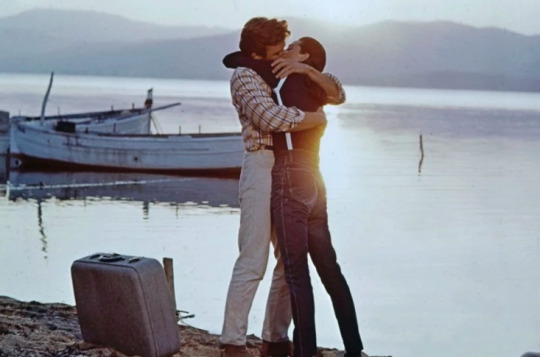
The way of taking what can be seen as a basic story and turning it into something so spectacularly beautiful and interesting is one of the most powerful aspects of film. This is what Two For The Road so greatly achieves, as from afar, Joanna and Mark’s relationship is seemingly regular, with no great glory or achievement involved. Yet it is the way in which the story of this marriage is executed that gives it all the glory. All shot on location, the trip we take with the couple may seem like a simple journey, yet the storytelling and execution of emotion through the writing and stylistic choices is something so outstanding. This road-trip certainly can be seen as a symbol of Mark and Joanna, the cars they drive being symbols of the adventure that is marriage. All features of the film are utilised to create a powerful story, the differing environments being a significant aspect, as they tie into the theme of change. The costuming too plays an important part in the emotive experience of audiences, as Joanna and Mark’s wardrobe moves from colourfully casual and free to professional and tight-fitting, representing how they’ve settled, after having married and had children.
Henry Mancini’s score is something that is so tear-jerking, moving audiences through the motions. Gleefully slow moving strings accompany the scene where Joanna professes her love for Mark early on, ditching her ride and humorously imitating a traffic signal, surprising Mark. He questions, “what happened to your slick friend in the Alfa Romeo?”, to which Joanna responds, “I told him I was in love with you, so he put me down”. These exuberantly happy moments are paramount in the story, as the simplicity and beauty of travel, food, romance and new meetings create interest. You can really say that not much happens throughout, but it is the collective moments that make it all the while. Moments like Hepburn’s bright red top on the background of a French food market on the day she met Mark and getting to know him, as they too discuss their values, ideas and past. Travel is such a wonderful pastime, bringing heart, experience and memories of a lifetime, as well as closeness and complications. This makes their journey such an interesting and beautiful facet, as it is a remarkable setting for stress and joy throughout. Moments like this they share, in an amusing scene where they drive in ‘the old MG’. Joanna wears a bright pink ensemble and announces her pregnancy, as her and Mark toast with a cup of coffee in the car, just before it sets fire & they spontaneously find a hotel to stay in after being isolated from their accident.

The contrast between the beginning of and later on in Mark & Joanna’s relationship is a clear indicator of their fading infatuation, though love is still there. Though always in France, always travelling together in a car, and staying in the same hotels over their decade spanning relationship, audiences can clearly see the difference in their attitude towards each other. Where there was enthusiastic adoration in their first stay at the luxurious hotel in France, years down the line, Mark draws up architectural plans, as Joanna utters ‘aren’t you coming to bed at all?’. What was once a fun-loving beach holiday, where Mark fought with and then proposed to Joanna, is now a dismal seaside lounge chair for them to sit in, as they vacation there years later, with almost nothing to say to one another. The bitterness that marriage can bring is noted very well in the monologues that Mark and Joanna deliver to each other. With Mark asking about their relationship, stating “is it worth it?”, Joanna responding with, “Yes it is worth it sometimes, only not now”, this being a strong summary of a long-lasting marriage. As arguments test their devotion to one another, the ending scene shows Joanna and Mark driving home from a party, discussing their place in their marriage. As Mark taunts Joanna with questions about what she might be doing having not been with him, he goes onto ask “What can’t I accept?”, to which Joanna replies, “That we’re a fixture, that we’re married. You go on about my leaving you, when I’m always still there. You sure you don’t want me to leave you?” Mark replies with, “Positive.”
Ranked at no. 57 on the American Film Institute’s 100 Years…100 Passions list, Donen’s ‘Two For The Road’ can be seen as one of the greatest and certainly strongest love stories in cinema that there is. A romantic marvel it is, due to all it’s ever-changing realism and depiction of what could be true love. Strangely very modern for it’s time and still very contemporary today, Donen’s work so artistically mixes comedy with romance and drama. Expertly executing these genres all at once, a message is sent to audiences on the beauty of love, even amongst all it’s painful change.
Stars Out Of Five: 4.5/5
visit at: dreamsofthescreen.com
#audreyhepburn#audrey#albertfinney#1960scinema#newwave#retrocinema#retrofilm#vintage#costumedesign#filmwriters#blogger#writersoftumblr#hepburn#1950s#henrymancini#review#analysis
0 notes
Text
How 1917 Captivated Audiences Audiences Across The Globe - Review & Analysis

George Mackay in ‘1917′
When Sam Mendes’ ‘1917’ hit cinema’s, immediately talk of award show buzz was brought to the table. ‘It is not a film, but an immersive experience’ was uttered around me in late 2019, as I wondered what I had yet to encounter. All appearing as a continuous shot, it is the incredibly expert and inventive cinematography that swept audiences off their feet. The rawness of youth and inspiring nature of two men’s stories on the forefront of the First World War all communicate the continuous idiocy of warfare, even today. As a stage director, Mendes’ staging and shock-horror tactics make 1917 emotionally dazzling and all the more thrilling.
Directed by Sam Mendes, it was based on his own family history, as his grandfather worked as a messenger on the front in 1917. Having had the idea of communicating stories of his grandfather for years, upcoming actors George Mackay and Dean-Charles Chapman were cast to play lance corporals Schofield and Blake. Enlisted on a mission to deliver a message to call off what could be a disastrously fatal attack, the young men must cross enemy lines and risk their own lives against the odds to save their fellow troops. However, the Germans had cleverly left their trenches, appearing as though they had fled, when they really are waiting in hiding, ready to attack the British.
With this intense storyline, it is the way in which the plot is executed that is superb. Winning the Academy Award for best cinematography, Roger Deakins’ filming is expertly expressed, and it is the way in which 1917 is shot that is such a defining feature. The technical accomplishments were not just embellishments, but something that made the film. This one shot technique was created through stringing a number of takes together and edited in a way to appear as if audiences are watching a single, gruelling journey. This long shot experience is never dull or continuous, as with every turn there is suspense and terror. Director Mendes had said that he “wanted to tell this story in two hours of ‘real time’. So I felt like it was a natural thing, to lock the audience into the men’s experiences”. In terms of shooting, cinematographer Deakins claimed that the longest take was seven minutes. Seeming like a new cinema milestone had been reached, the choreography of the film is stunning, as we are literally following the soldiers so closely that the audiences’ POV is close to the characters’ perspectives. It is this cinematic advancement and challenge that sets 1917 apart from other war films like it.
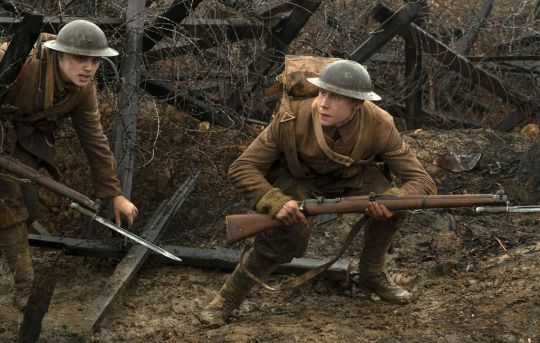
George Mackay & Dean-Charles Chapman in ‘1917′
With mostly tracking shots used, camera dolly’s chase after George Mackay’s character in one of the film’s most intense scenes, where a debilitated and truly traumatised Schofield sprints directly through the frontline, with nothing to defend himself. A behind the scenes look at this moment in the film sees Sam Mendes sitting on the back of the moving camera set, towed by a truck. With hundreds of extra’s running onto the field and real-time blasts bursting from the ground, Mackay as Schofield so expertly runs through the scene untouched, having audiences like myself wonder how many times that take needed to be done. Mendes commented on the hardships of this ambitious style of filming, saying, “the dance and the mechanics of the camera all have to be in sync with what the actors are doing” & “we had to rehearse every line of dialogue on location…the world has to be crafted around the rhythm of the script”. And so it was, as in one scene the camera chases Schofield through a burning hamlet, the lighting perfectly revolving around him, creating a wonderfully timed, yet, chaotically frightening moment. Though some critics had tried to find something to pick apart the film, stating that audiences had little character backstory to grasp onto, as we are only given insight into the lives of two lone soldiers. Yet, where some longed for connection to the collective experience of war by featuring many more soldiers, or developing gripping backstories, 1917 simply didn’t need this to be interesting. Given how the film plays out, there is no need for an emotional backstory to have us connect to a character, when the circumstance itself and what is presented throughout is paramountly gripping and soulful. Some had said that though the filmmaking is brilliant, the story isn’t all there. Yet, it can be said that by following a straightforward plot line with a simple task, we can delve deeper into a singular experience. This is a story played out through wonderful composition, actor Mackay saying “it was like a piece of theatre with every take”.
Earning ten Academy Award nominations, the realism of the entire feature is breathtaking. The horrifically intense, but sometimes beautiful and saddening imagery seems like something straight out of Wilfred Owen’s ‘Dulce et Decorum est’. From taking us deep into the trenches, through the dry landscape of France, to the empty rolling fields, and through abandoned, bombed out villages, we see changing journey in real time. This grand richness and variety in scenery creates interest easily, having us feel like we’re walking through a simulation. Yet with the same heart as war films that we so know, the raw nature of the world in 1917 is what creates the intensity. A strange sense of calm at times is not what you’d expect from a film so heavy, but the contrast between walking with the corporals through a peacefully lonesome cherry blossom field and sprinting from death through a town on fire is what creates the emotional rollercoaster. Amongst the calm, there is joy and a reminder of home in some scenes, showing us the purity of life before that life turns into something so nightmarish.
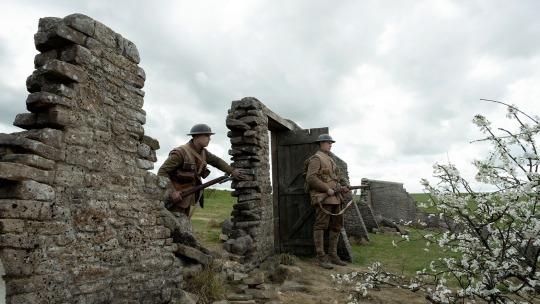
Where some war films may feel the need to use a score to build up suspense, 1917 holds not only suspense, but pure shock and horror in it’s scenery. As Blake and Schofield cross enemy lines, the sights they encounter come with no alarm. Decaying bodies amongst the mud, a deep gash for Schofield when running into barbed wire, what they come across is just as confronting for audiences. In a death scene during the film, there is no crescendoing music to create tension or warn audiences of what’s to come. No dramatisation or unnecessary glamorisation of war is there, making the moment strangely calm and far from honourable. No phoney supporting soundtrack that is needed to intensify the moment or remind audiences that this is indeed a scary scene, as we are with the soldiers in the moment, seeing what they see first hand.
Where there war, there is talk of it’s futile meaning, something that films based on wartime experiences effectively communicate. The hope of home and supposed promise of glory in the First World War is shattered by what really happens - death. It is this about war films that I so ardently love - the foolish history of how war was viewed & that these youthful deaths were honourable. By watching films like 1917, we are reminded of the repetitive idiocy of warfare through remembering one of the worst. The touching inspiration for 1917 coming from director Mendes’ grandfather reminds us of our family connections to war, creating a personal moment. And heartening family moments like these are continuously brought up throughout, reminding us of the corporals innocence, and ultimately, their poisoned youth due to warfare. As Blake walks through a field of flowers, he recalls a story of a time when picking blossoms back home took a whole day, greatly contrasting to now marching through the fallen orchard. This joyful story breaks our hearts as we can see the mercilessness of war, when touching on an innocent story, showing how much had changed for these characters. Scenes like this that were once beautiful have become ridden with hurt, and though the green fields of France may look lovely in the film, they are now laced with death.

A moment that reminisces on the nostalgia of home is when amongst soldiers in the woods, a man sings The Wayfaring Stranger. This mesmerising folk tune is almost a reflection for the soldiers themselves, as it speaks of the peace in death, comfort of home and journey of life, sung just before the group of men go into battle. Mournful lyrics like, ‘There is no sickness, no toil, nor danger, in that bright land to which I go’ & ‘I’m going there to see my Mother, she said she’d meet me when I come…I’m only going over home’, reflect on the possibility of death itself. Yet at it’s core, this scene is eerily calm, as we can hear the futility and sadness in this moment.
With a background in stage directing, Sam Mendes’ 1917 certainly was a theatrical spectacle. Profoundly moving, the inventive staging and richness that is presented brings the realism of a wartime experience to life phenomenally, making 1917 one to remember. Full of heart and soul, as many war films are, what sets apart Mendes’ work is his unorthodox approach to filmmaking, which was successfully pulled off. Emotion and intensity, there is no doubt in saying that this is one of the greatest war films made.
Stars Out Of Five: 4.5/5
0 notes
Text
Michelle Obama’s Radiance in Netflix’s ‘Becoming’ - Review
The classiest first lady radiates light and hope on her tour for her autobiography ‘Becoming’.

As memoir of the Former First Lady of the United States, Michelle Obama’s ‘Becoming’ was received with great praise, the 2020 Netflix adaptation was sure to do the same. The radiating light and hope that this icon bears is highlighted in documentary, directed by Nadia Hallgren. The pure poise and intellect coming from the former First Lady is one that is rarely seen in many leaders nowadays, as she shows her truly open support for minorities. Inspiring those close to and far from her, Hallgren’s film strictly gives us insight into Obama’s growth and continued, beaming influence. Though with not nearly enough time to go further than skimming the surface of the woman she is known to be, the feature still ticks the boxes of what a documentary should be.
Following Obama on the tour for her autobiographical novel ‘Becoming’, she crosses the United States to speak on her experience living and working as the 44th First Lady. Michelle’s life is split into moments at home, her time on the road working, as well as perfectly discussing touching issues with the younger generation. As documentaries go, ‘Becoming’ certainly offers rare insight into the woman behind the glorified persona that she is expected to live up to. As we get to see Obama dashing to and from high security events and paraded around in Range Rovers, we can feel as though we’re getting an exclusive look into what goes on behind the curtain. Yet, as much as these scenes are shown & backed by an emotive soundtrack, we’re never given real insight beyond the inspiring, lighthearted material. We are given the promise of hope from the Obama’s, followed by the shots of stadiums filled with crowds staring at the former First Lady in awe, as she somehow relates her experience living as a family in the White House to the audience. Sure, there are some snippets of secrets that we wouldn’t have heard from the media, like how Obama had told her butlers to take off their tuxedos and stop serving her kids’, so that they can be raised knowing how to make a bed. Or a story about as the White House was lit up in rainbow to celebrate the legalisation of gay marriage, she and daughter, Malia, snuck out to join the moment.

However shallow the documentary’s presentation may be, it is the real nature of Obama that is powerful. Following her time after the 2016 election, she highlights how the ending of her role as First Lady affected her, stating ‘I was sobbing on Airforce One for 30 minutes. I think it was just the release of eight years of trying to do everything perfectly.’ In another moment of reflection, she touches on that same pressure, revealing, ‘It’s hard to wake up everyday and maintain that level of perfection that was absolutely required of me and Barack as the first black President and First Lady.’ Again, we are only presented snippets of touching moments to give a sense of ‘realness’ to Obama’s life. Yet, by keeping in shallow waters, we are left without an in depth look at who Michelle really is, beyond the glamorisation of her life as a political icon. Her grand elegance and light is there, but what really drives her to stand so proudly on such a high pedestal? And why is she so greatly recognised as a universal inspiration? Touching moments that are seen is when she visits her family home in Chicago to speak about her life growing up. There is, of course, a great contrast between what she was and has now become, which can be said is a vulnerable place to go, as the role of a First Lady can be seen or expected as someone born into privilege. Certainly not a rags to riches story, but we can see the environment of her real upbringing, and how the people around her made her who she is today.

To find relatable ground with audiences and speak on the importance of ones personal journey is what is touched on the most, getting those watching to see eye to eye with such a respected leader. When visiting Chicago, she speaks about losing her father to MS, as well as sharing the sweet story on how her and Barack met at a law firm. These aspects give us a sense of her as a ‘real’ person who’s ‘just like us’. This realness is further seen when following Obama around as she speaks, not only to, but with wide-eyed college students on stops of her tour. These scenes in the documentary can be seen as the most compelling, as it is what Michelle is best at - being a leader & boldly inspiring the next generation to come.
The importance of her visiting community centres to talk to the younger generation, is not because it’s something that is required as the job of First Lady, but because it is something that she genuinely wants to do. To connect and share the relevance of a journey. Where we could see First Ladies as passive and only a figure fulfilling their duties, it’s clear to see that it means so much more to her. She states, ‘I crave some longer experiences with young people. Through the community events. The tour could do a great job of giving me a little taste of it’. As a feminist, supporter of the LGBTQ+ community and advocate for racial issues, her democracy and connection with others shines through. Where politicians lack empathy, Obama’s everpresent support for all is what has the youth grasping at her for advice, and listening to her with sheer adoration. Speaking on using your voice in the world today, she states, ‘we can’t afford to wait for the world to be equal to start feeling seen. We’re far from it…so you’ve got to find the tools within yourself to feel visible and to be heard and to use your voice.’ These moments focusing the value of ones education and personal journey can strike a chord with the younger generation, as Obama’s teachings come from such a powerful place - her experience.
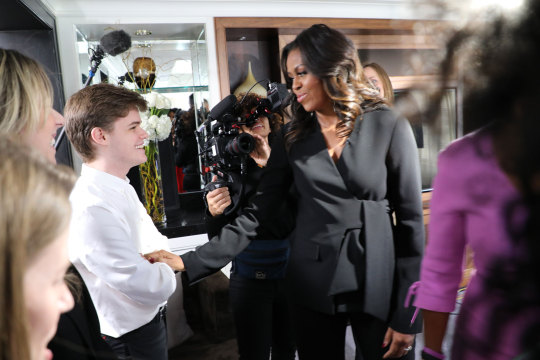
Another memorable quote from Becoming that sums up Obama’s heartening attitude towards groups of young dreamers, stating, “I have been at, probably, every powerful table there is in the world. I’ve been at G-summits, I’ve been in castles and palaces, in boardrooms and academic universities. And I’m coming down from the mountaintop to tell every young person that is poor and working-class and has been told, regardless of the colour of your skin, that you don’t belong, don’t listen to them. They don’t even know how they got into those seats.” With oppression brought unto her and Barack as the first Black President and First Lady, millions can even sympathise with her time in the White House. Amongst all the pressure and radical racism coming from so much of the United States throughout her eight years leading, to relate to todays generations is a through her embracing of youth and diversity is a superpower. It, again, is this pure openness and encouragement of the younger generation that sets her aside from any regular politician. The promise of tomorrow and inspiration given to those once like her years ago is what makes a leader.
As a sense of cool is brought to the table, as Obama dresses in a yellow silk frock, with striking Balenciaga boots before walking on to speak to another crowd of thousands. The closing scenes are backed by Frank Ocean’s ‘Godspeed’, and one of her fitters comments on a blazer of hers that reminds her of Elvis. Obama’s mix of grace, understanding and style are all elements that have her seen as such a powerful figure. It is the quality of openness that we so love in figures like Michelle Obama. Someone dangerously and boldly supportive of minorities, like icons Malala Yousafzai or Princess Diana. Nadia Hallgren’s adaptation of Obama’s autobiography ‘Becoming’ hit Netflix in May of 2020 & successfully gave insight into the publicised life of Michelle Obama. Though skimming the surface of Obama as a person, we can see the grand influence that she had and still has unto others following her time as one of the most inspirational First Ladies of all time.
Stars Out Of Five: 3/5
0 notes
Text
The Abstract Point Of A Clockwork Orange - Review
Released for streaming on Netflix two years ago, is this a so called ‘masterwork’ of a film, or just cinematic satire?

Malcolm McDowell in 'A Clockwork Orange'
Based on the book by Anthony Burgess, Stanley Kubrick’s 1971 adaptation of ‘A Clockwork Orange’, proved greatly controversial, yet influential. The dreamy, edgy swinging 60s sets up the scene for ultra violent home invasions and tortuously explicit murders performed by ‘The Droogs’. Released for streaming on Netflix two years ago, is this a so called ‘masterwork’ of a film, or just cinematic satire? Surrounding the idea of free will, this can be tossed around endlessly and reviewed in philosophy as something problematic. But is this film’s talk of freedom and suppression all really necessary? It’s upfront commentary on humanity that can be deemed as abstract, yet is this label of abstract just an excuse to glamorise the utter violence? Or does ‘A Clockwork Orange’ stand strongly with a point in hand? We can say both. The retro aesthetics, in terms of costume & production design that Kubrick can be recognised for, do play into the significance and absurdity of this work.
Set in a dystopian England where the governed rules are anything but at liberty for citizens, morals aren’t only tested, but are completely rejected. In this world, the government find order in good behaviour, something that the main character, Alex, (Malcolm McDowell) completely detests. Alex has no moral limits and gains pleasure from violence with no concern for the consequences. Within the first half an hour of the film, we see him and his gang of ‘droogs’ beat up a homeless man and mercilessly invade an old mans home, robbing it as well as raping and murdering his wife. Though labelled as a lesson in testing how far freedom of choice can go, A Clockwork Orange’s meaning can seem scattered.
Seen to represent someone so outwardly alive in his lack of concern for society, Alex’s mad challenging of human morals tests the meaning of freedom. But given themes, are they just barren and only strive to portray substance? It can just be seen as senseless violence for many. The intensely rebellious attitude is a reflection of the oppression faced in this film’s universe, and ultimately is an exaggerated comment on society today. Yet, you could say this about a film like Dirty Harry or Pulp Fiction, given their brutality. This theme, focusing on order vs chaos in society, is no doubt relevant, but however meaningful is it? The meaning left in it could be that, through it’s distressing realism, it so rawly opens ones eyes to today’s illicit society. Commenting on the confusion surrounding the film’s meaning, Kubrick stated that, “It is a story of the dubious redemption of a teenage delinquent by condition-reflex therapy. It is, at the same time, a running lecture on free-will.” Furthermore, author Anthony Burgess writes in ‘A Clockwork Orange Resucked’, that the meaning is in the title, ‘A Clockwork Orange’ referring to one who “has the appearance of an organism lovely with colour and juice, but is in fact only a clockwork toy to be wound up by God or the Devil or the Almighty State”. In saying this, Burgess does confirm that from his perspective, this is a comment on human nature being sucked away by a totalitarian government. Yet, even given the comment from the author, our perspective as an audience is truly subjective.

In the author’s word, commenting that ‘A Clockwork Orange’ reflects someone who “has the appearance of an organism lovely with colour…but is only a clockwork toy to be wound up by the Almighty State”, refers to our potential for evil, and the importance of it in human nature. This is certainly a thought provoking theme, as most of the film is. The extreme capabilities of human beings can be an incredibly positive light or looming darkness, given which we choose to act on. Yet when this potential is squashed by a higher state, we can question whether one has free will, if it is still controlled. In a scene where Alex’s rebellion in lessened by Ludovico’s Technique, a process in which he is brutally forced to watch films of atrociously violent acts, with treatment in order to make him physically sick at even the thought of committing any crime. In hope to make him less of a threat to present society, he is less of himself. Again, we can think about the fact that is is of course necessary to change such wicked behaviour, but we can also think about how it could be, had we not chosen to create any governed rules.

After seeing state officials confirm that Alex has been cured of his homicidal behaviours, a prison chaplain states, “Choice! The boy has not a real choice, has he? Self-interest, the fear of physical pain drove him to that grotesque act of self-abasement. The insincerity was clear to be seen. He ceases to be a wrongdoer. He ceases also to be a creature capable of moral choice.” In total, Alex’s behaviour is ceased to be wrong, but he is also ‘ceased to be capable of choosing for himself, since he had been rewired to believe what the state had wanted him to believe - that acts of violence simply are wrong. To the normal mind, this isn’t a hard concept to grasp, as we are surrounded by basic morals that tie in with our empathy. Yet to someone with more sociopathic or psychopathic tendencies, this concern isn’t there. So, again, Kubrick leaves us questioning whether or not people in this state of mind should have the choice there in the first place, as they are unable to distinguish that morals are important in humanity.
Furthermore, in 1973, Kubrick decided to ban A Clockwork Orange in the United Kingdom, due to continuous upheaval. Renowned film critic Roger Ebert gave it two out of four stars, stating that it was an “ideological mess”. Comments on it’s explicit sexuality, dehumanisation and violence were made, with some thinking that the point of the film in itself was missed. As some claimed it’s content was to create a raw piece of art, others claimed it an offensive excuse to pointlessly portray horrific scenes. And horrific the scenes are, though with fashionable features, the torturously disturbing scenes of ‘The Droogs’ murders’ are certainly crude, and have no backstory whatsoever. These brutal scenes can be seen as damaging to on audiences, or even dangerous. What kind of insight are audiences given when shown such destructiveness?
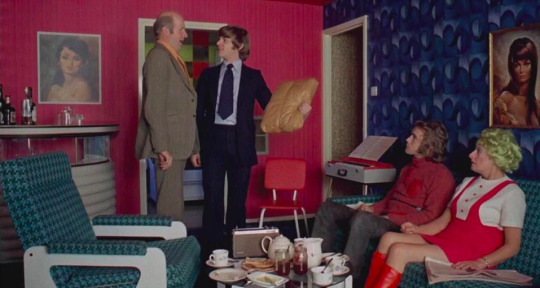
If we talk about the stylistic features of Kubrick’s adaptation, they have certainly played into it’s iconic status, having audiences sometimes classify it as a performance art piece, rather than a film. The renowned costumes of ‘the droogs’ have been used repetitively as Halloween costumes, as well as the storyline being referenced in The Simpsons. The production design is, without a doubt, gorgeous, kooky and as abstract as the film’s meaning. The interiors stun with colour blocking wallpapers, framed pictures of 1960s models and record players spinning in one room. The sense of 1960s jazz certainly is there, with a slanted, modern design, that Kubrick is known for in other works like ‘The Shining’. Whilst Alex and his gang members commit crime, they dance along to Gene Kelly’s ‘Singin’ In The Rain’, and as Alex is tested through Ludovico’s Technique, a recognisable symphony by Beethoven is played. The 1960s wardrobe bursts with colour, an exaggerated view of the Britain in the swinging sixties. Audiences are attracted to these joyful features like music and fashion, the stylistic features making it such a cult classic. A cult classic needs to be fashionable, but is this fashion in the film pretentious? Especially when surrounded by such violence, as though to say that it’s chaos can be softened by pretty interiors or a recognisable score. Or does it make it all the more disturbing through adding joyful song or colourful designs, as they so oppose the distressing acts that Alex and his droogs perform. Had it not had Kubrick’s touch, would we view it the same way? Though Academy Award winner Milena Canonero’s costumes and John Barry’s production design remaining outstanding, does their glamorisation gloss over the underlying trauma of the plot? This type of questioning is something we can participate in throughout watching Kubrick’s production, as both it’s ideas and meaning are not black and white.
Kubrick’s adaptation of ‘A Clockwork Orange’ is clever in that it has us wondering whether or not it has a point, yet regardless, audiences are still left thinking about the impact of immoral behaviour and how our society responds to it. However consequential it attempts to be, it really can also be seen as blank, leaving audiences to decide on which to focus on. The pop-art aesthetics of the film can overrun the meaning or either try to stir us away from the barren landscape that it can be seen as. However strongly critiqued and analysed it may be, it’s meaning is all the more subjective, both creating interest and successfully winding up audiences.
Stars Out Of Five: 3.5/5
4 notes
·
View notes
Text
How ‘Malcolm & Marie’ Did Manage to Keep Us Watching - Review
Though already critiqued, writer and director Sam Levinson's lockdown project 'Malcolm & Marie' does still soar and fulfils much of it's own potential.

Zendaya & John David Washington in 'Malcolm & Marie'
Widely anticipated black and white drama ‘Malcolm & Marie’ gathered mixed opinions, yet the portrayal of it’s intense emotions succeed to highlight the push and pull between a young couple. Starring Zendaya and John David Washington, the interest created in the simplistic feature is the indulgent argument sequence that is the film itself, very real in it’s reflection. Director Sam Levinson’s writing didn’t garner praise, yet it is the simplicity of it that should be admired, as the monologues cleverly portray the ever-changing emotions throughout. Though unoriginal through it’s format, ‘Malcolm & Marie’ makes a good point in staying relevant to pop culture today, and though criticised, is a very decent work with an impressionable and impassioned script.
‘Malcolm & Marie’ tells the tale of a 20-something year old couple returning from a successful premiere of a film that Malcolm (John David Washington) had worked on for years. The argument that arises from Marie (Zendaya) recognising that her boyfriend had forgotten to thank her upon presenting the film, stemming from her feeling unappreciated in the relationship, especially when compared to Malcolms work. As a former drug addict, it isn't hard to notice that Malcolm’s film seemed to base itself off of his girlfriend's own experience, as it tells the story of a young girl struggling to get clean. Director and Writer Sam Levinson’s script has been titled by New York magazine as having ‘utter emotional inauthenticity’, yet however simple it may seem, it is this harsh simplicity that analyses the unbalanced relationship. Levinson had previously worked with actress Zendaya in widely popular drama series ‘Euphoria’, casting her in the main role, as a drug induced, troubled teen. And this character is definitely reminiscent in Marie herself, Zendaya's performance creating the most tension, similar in 'Euphoria'. This very performance of hers had even garnered Oscar buzz, the dark and quiet moments of 'Marie' being the most powerful.
From the ‘Malcolm and Marie’ script, audiences don’t get an abstractly cliche or hollywood-esque writing style. And sure, the black and white aesthetics can be deemed as pretentious, and both characters screaming profanities down the hall at each other or wildly flailing their arms in protest doesn't amount to much, but Levinson creates a raw, emotional screenplay. A screenplay that analyses a relationship and allows audiences to understand the push and pull between Malcolm & Marie’s perspectives.

With just two characters, their monologues are what become paramount in the story. Marie defending her position with lines like, “agents, producers, crew members, actors, f***ing fictional characters get more respect and empathy from you than I do” & “You know what, Malcolm? I feel like once you know someone is there for you, and once you know they love you, you never actually think of them again.” Perspectives differ and an upheaval begins, with the two’s insecurities being revealed, as well as their fragile ego’s being targeted. As the complications are furiously discussed, what it comes down to is the way that Malcolm & Marie perceive each other, seen through Levinson’s writing. As Malcolm’s perspective of Marie reveals his attempts to understand her insecurity, he targets her with lines like “I promise you, I can hurt you ten times worse. You’re a f***ing featherweight, a level-one boss. I can snap you like a twig.” & “you may have gotten clean, but you still haven’t figured this part out yet. Why you love being hurt, traumatised and f***ing eviscerated? It’s not normal. It’s not healthy, and it permeates every aspect of our relationship.” Yet, Marie’s pain is revealed in lines like, “the difference is you were able to take all the ugly s**t and make it something beautiful. Something good. Something that could move people. But, Malcolm, I’m stuck with it.” The writing is straightforward, but it is the monologue moments that allow the cutting emotion to come through, and for us to see what’s really under their skin. And that mostly is their insecurities and lack of consideration for one another, something prevalent in many relationships today, giving audiences something to relate to, and hopefully influence them positively. Yet as Marie begins to understand Malcolm’s apparent reasoning behind his mistake in forgetting to thank her, she utters, “The man I’m looking at right now is as good as he’s going to get. You yelling at me in a bathtub about how you’re going to snap me like a twig is the best and worst of who you will be in this relationship. And that’s why you can forget to thank me in your speech.” Again, these sharp lines aren’t glamourised, but hook audiences to the characters experiences, rather than just the plot at hand. The plot is the character’s experiences, yet it is their speech-like moments that strive to stand out & prevail in doing so. Where other critics could have been looking for dialogue sprinkled with fairy dust and rhetorical metaphors, as most Hollywood rom-dram’s go, Levinson succeeds in communicating the character’s true hurt, because of the realistic bitterness in his writing.

Made during the 2020 Coronavirus lockdown, Levinson’s arthouse attempt needed to have interest in a simple story, given the limitations of the production. Set in a contemporary, empty home, the costumes never change, nor the location. All audiences have is the debate between Malcolm & Marie themselves. Yet the impassioned speeches create said indulgence for audiences. From a fight in the middle of eating mac and cheese, to Marie frightening Malcolm with her acting skills, the continued substance is in the ever-changing scenes. The acting in this feature is, of course apart of the heavily intense feelings that are communicated. Zendaya’s acting skills are at peak when compared to any of her previous, Disney-related projects, as she is able to take on a true performance in a twisting leading lady role. John David Washington has a running streak for emotionally inquisitive pictures, and could certainly keep up with the demanding performance. Within the two hours of the argument saga, there was room for growth that wasn’t used, as Malcolm and Marie rarely change and remain two dimensional. Yet, it can be argued that the entire plot was only within a four to five hour time period that Malcolm and Marie spent together, meaning that it's lack of development was realistic to the time set. Something to be positively noted is that with this short time period that Levinson focuses on, it allows us to really delve into and analyse an unbalanced relationship to a considerably good extent, it remaining insightful.
However much it may seem like an ‘homage’ to Old Hollywood black and white pictures or ’Film Noir’ features, Levinson’s interpretation doesn’t sell too well, as it seems like a parody or attempt at reinventing classic cinema. As appealing as it looks, the aesthetics come off as quite two dimensional, with both characters longingly staring as they lonesomely smoke a cigarette, or with repetitive close up shots seeking to distinguish their deep-seated emotions. Additionally, something that was interesting was the juxtaposition between the classic cinema aesthetics when put with a modern story. As Marie changes from a sleek silver dress into a basic white tank top, with the black and white setting, you might expect her to be dressed in an Old-Hollywood, Marilyn Monroe-esque costume, delivering corny, Casablanca inspired lines. Yet, her and Malcolm sit on the porch, scrolling through their phones, with no sweeping soundtrack or dramatic stylings.
As this is a modern love story, Levinson chooses to create homage, but still cleverly focus on topics that are significant today. However pretentious others may view it, his comments on the oppression that African-Americans face in the entertainment industry does ring relevant, especially to the past year. Although a white man himself, Levinson doesn’t overstep boundaries when he writes Malcolm commenting on his hardships in the filmmaking world as a black man. As Malcolm compares himself to the next Spike Lee, Marie touches on the idea of an Angela Davis biopic, as well a poking fun at critics attempts to support black voices in the film industry. These comments create some substance an lift the story considerably, in a way to reach creators or minorities today.
Furthermore, as ‘Malcolm and Marie’ received backlash from writers at ‘Rolling Stone’ and sparked opinions circulating on Twitter. Yet, this backlash commented on the attack at film critics that the movie seems to point towards at times, with Malcolm aggressively threatening a writer of a mediocre review that his work got, again, his sensitive ego on display. And sure, the argument sequences were truly overplayed and there was little character development. Yet again within the time frame that Levinson set, as well as the COVID19 production restrictions, there wasn’t much room for any major changes. And the pretentious, teen-like fighting between the two is exhausting to watch play out. It can be said that Levinson had potential to create a story more complex, but it is the simplicity of the monologues, not arguments, but monologues, that grab our attention and create a gripping story.

As the trailer put it, “this is not a love story, this is the story of love”, and with that, love needed to be represented realistically. Though given backlash, writer and director Sam Levinson’s independent drama ‘Malcolm & Marie’ flourishes in it’s representation of a relationship on thin ice. Though the art direction and cinematography attempts to distract us or gloss over the straightforward writing, the performance is still strong, despite critics picking apart the simple and unchanging plot. Levinson’s attempt at an arthouse film didn’t end up being niche, but was widely received by many and greatly succeeded in it’s dramatic communication. As some can see it as two hours of repetitive quarrelling, it is the small, but meaningful journey that Malcolm & Marie take in discovering what the other needs that is relevant. Where NPR said that it 'can't seem to find it's meaning', the meaning can be seen in the words. It is the writing that gives insight into both characters and is what highlights the basic plot in Sam Levinson’s romantic drama, ’Malcolm & Marie’, creating interest in a film that was, at times, deemed too tedious.
Stars Out of Five: 3/5
0 notes
Text
The Emotional History of Lili Elbe - The Danish Girl Review
Transgender pioneer Lili Elbe breaks our heart and attempts to teach us a lesson of authenticity in ‘The Danish Girl’.
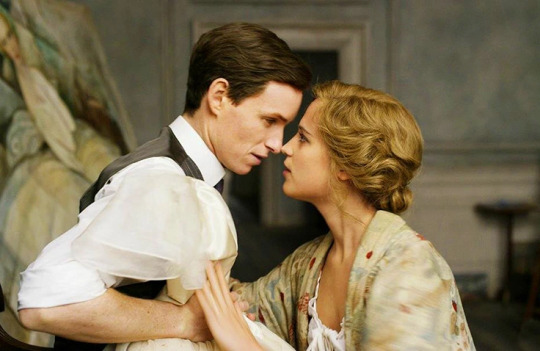
Eddie Redmayne & Alicia Vikander in ‘The Danish Girl’ (2015)
Tom Hooper’s ‘The Danish Girl (2015) bursts with life, change & controversy, seen through it’s portrayed emotion, score & production design. Based on the touching story of 1920s Danish transgender pioneer, Lili Elbe & her wife Gerda Wegener, it focuses primarily on the unconditional love and support between the couple throughout. It is through the convincing writing that we get to see both partner’s go through life-changing transformations to understand their place in a world not so accepting of their beliefs. The artistic focus that is held on the film showcases the significance of the story. However, the portrayal of supposed ‘femininity’ was one that can be seen as offensively diminishing in it’s attempt to represent what it means to become and be a woman. Told through the eyes of cis-men, where there is a pioneer, there is controversy, especially in the LGBTQ+ world.
Set in 1920s Copenhagen, marriage between painters Gerda and Einar Wegener seems to be prospering in the artistic, seaside city. As the two appear to be made for each other, the complication that arises is life-changing for both characters. As Gerda’s friend Oola is unavailable to sit for Gerda’s painting, she persuades husband Einar to put on a ballerina’s costume, where he has a great revelation. Eventuating into belonging as ‘Lili Elbe’ after months of playing dress up, it is Gerda’s support that shows the poignancy in Lili’s journey. As Oscar-Winner Eddie Redmayne portrays both Einar Wegener and Lili Elbe, Swedish actress Alicia Vikander’s performance as Gerda earns her the Academy Award. As much as the film obviously focuses on Lili’s journey, Vikander steals the performance more than Redmayne, and she is just as significant of a character in the tale. However, in the 2016 Academy Awards, Vikander was still listed as ‘Best Supporting Actress’. And support did her character do. As the perspectives of Lili change drastically, Gerda’s unconditional love has her view of her partner staying the same, with her care only growing stronger. Having been known for representing strong female leads gracefully in pictures like ‘Testament Of Youth’, Vikander’s performance utters strength and an inspiring feature in the writing of the film. As Lili has an interview in Paris to discuss the possibility of a sex change, she states, “The fact is, i believe that I am a woman. Inside”, to which Gerda replies, “And I believe it too”.
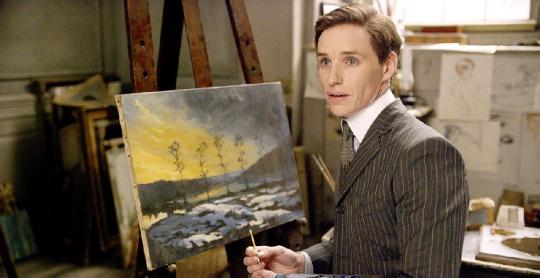
In a world where no one could begin to understand what transgender even means, Gerda believes every word that her partner utters. As she never doubts Lili’s transition, and although there is constant grief and fear, we see how Gerda’s love overrides any challenged faced. Even though they may have not known it, that devotion was always the foundation of their relationship. This pure love is certainly recognised by Einar/Lili, as she utters, “I love you, because you’re the only person who made sense of me”. Einar & Gerda both take on great change, viewers gaining a new perspective on transitioning, seeing that it is not only one person who goes through it, but the loved ones around them too who discover the meaning and hardships of authenticity. The beauty of the connection between Gerda & Einar or Lili is a great highlight of Hooper’s film, creating interest and bringing meaning to the tale.

In ‘The Danish Girl’ we explore the world of art in the 1920s, which was a greatly influential time period - the art deco and nouveau styles, further expression post-WWI. The costume, set design, cinematography and score all weave into making an aesthetically stunning film, as the life of two artists themselves appears as a painting on screen. With the costume design by Paco Delgado, the production design by Eve Stewart, cinematography by Danny Cohen & the soundtrack by Alexandre Desplat, all these creative components do a beautiful job in tying into the meaning of the story. The costume design is a paramount feature in Einar’s journey into discovering who Lili is, as he is surrounded by women in striking dresses, tutu’s and silks. Delgado’s dressing of Einar see’s him as a stiff man, very restrained in tight, uninspiring suits. Where as when Lili is seen, she bursts with life in colourful velvets and layered capes. The cinematography by Danny Cohen focuses on some rather extreme close ups, which at times seem like too much, as though we as an audience cannot distinguish a characters emotion & need help by a camera’s exaggerated shots. Nevertheless, the shots themselves are symmetrical, and resemble artworks themselves, as the costumes, sets and light are all convincing of the time period. Director Hooper stated that he got inspiration for many of the shots and production design from Vilhelm Hammershøi, a Danish painter who was known for his subdued and empty, light focused interiors. Thus, when working with set designer, Eve Stewart, this had a lot of the images on screen genuinely resembling something on canvas & the long summer nights in Scandinavia. The maximalist, bohemian interiors of the apartment that Lili and Gerda share upon moving to Paris for exhibition work showcase the change and gained freedom in the couple. As Einar is exploring more of who Lili is, Gerda is faced with the challenge of accepting her new partner, whilst grieving her old one. Gone is the lonely, repressed space in Copenhagen that once represented the couple, and new is the lively and luxurious Parisian loft. Alexandre Desplat’s superb score is one of the things that hits the nail on the head of the emotions that break our hearts in Hoopers film. The discord, romance and speed in the soundtrack all perfectly reflect the mix of discomfort, love and terror in the story throughout. The dissonant piano taps or legato strings in the forefront of some scenes further dive into the characters experiences. A soundtrack can sometimes only support a film, yet Desplat’s work has us further understanding the shame, affection and despair in Lili & Gerda. The visual and audial areas of ‘The Danish Girl’ surely succeed in portraying deeper significance in the world and experience of a couple undergoing an overwhelming change in a time that helped, but didn’t understand.

The real winner in representing Lili’s story is the spotlight on Gerda & Einar’s artistry. As Gerda’s paintings of Einar dressed up as ‘Lili’ are her big break, Einar gets to see who he could be. Where there is flowing freedom in Gerda’s art, Einar’s continuous, rigid landscape work of the trees at Vejle represent his suppression. As in one scene Einar reveals to Gerda that he had dressed as Lili as a young boy in Vejle, him painting that same place can be seem as him stuck there, as he was his true self in that moment. Women started to become more in touch with their sexuality in the 1920s, seen through simple acts such as showing their ankles or dancing at speakeasies. This had screenwriter, Lucinda Coxon, cleverly making this aspect prominent in the transition of Einar to Lili & her discovery of herself. Einar is surrounded by nudes in his life, seen in his fellow workers art, his wife & specifically in a scene where he can visit a peep-show, even examining a cisgendered stripper there, to mimic it himself. In a scene where Einar visits As Gerda paints nude portraits of the character ‘Lili’, Einar himself can see who he truly is, as so much of the transgender experience would be defined by ones severe gender dysphoria. As the couple’s careers are both greatly visual, we can literally see the meaning of their works and how it ties into their lives - Einar feeling oppressed is his art pieces & Gerda discovering who her partner truly is supposed to be through hers, as well as the importance of being comfortable in ones raw body.
The controversy that surrounds ‘The Danish Girl’ is the fact that the cis-men that worked on it have succeeded in creating an untrue and fictionalised impression of womanhood.
A writer on site ‘IndieWire’, Carol Grant wrote a piece on how Hooper’s film was potentially harmful, stating that “In ‘becoming a woman’, Lili gives up painting to become a department store salesgirl.’ As Lili utters, “I want to be a woman, not a painter”, Gerda teases, stating “well, some people have been known to do both.” It can be argued that as Lili is an amateur in even being a woman, that she is uncertain of how to act accordingly & can only base herself off of stereotypes. Yet this plot line is never mentioned, and we as an audience are left with a badly represented and shallow idea of what it means to be a woman. Aren’t we meant to be inspired in seeing the authenticity in an early transgender pioneer? Yet this girl seems rather fake in her freedom, as we see how her overplayed feminine gestures seem to gain more merit than her actual spirit. Why does Lili’s early life have us see her delving into housewife activities, such as focusing on what scarf she loves or how to properly spray a perfume, rather than showing audiences what really means the most to her?
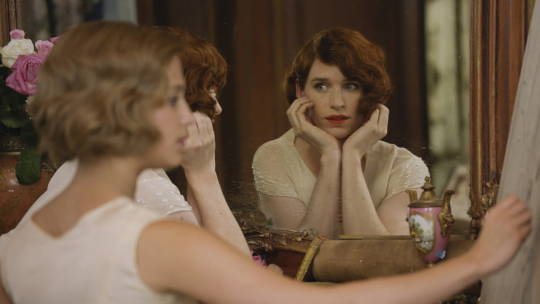
In moments that Einar reveals his truth to Gerda, we get to hear lines that do resonate well with the experience of a transgender man or woman, stating, “I think Lili’s thoughts, I dream her dreams. She was always there.” But Hooper never presents what Lili’s dreams or thoughts really were. It can be said that Lili never had enough of the time to fulfil these wishes, as (spoiler alert), this story ends with a tragic death. Yet Hooper had every opportunity to give us some insight into Lili, rather than just what her favourite nightdress was. This superficial focus on Lili separates her and her meaning greatly from the cisgendered characters, like Gerda herself, and Hans, a friend from Einar’s hometown of Vejle. Both Gerda and Hans are empowered through who they are: their ambitions, their careers, their empathy etc. By separating Lili from her loved ones & characterising her through her femininity only, this is potentially damaging to the transgender community, as trans women are too often seen as something that isn’t real or is a joke. We could have seen Lili as proof that transgender women are anything but fake and are so much more than just someone dressed up to the nines. There is depth in all humans, and by lacking this in Lili, her character only supports the harmful view that the trans community isn’t legitimate. Furthermore, the fact that Eddie Redmayne, a cisgendered man, played Lili Elbe didn’t sit well with many as this film too had opportunity to showcase the experience of a real transgender woman. Yet, this move was most likely made in order to sell the film to audiences, Redmayne being a well-known and praised actor.
Despite a lack of depth at points, Hoopers film still seems to soar in it’s skilful artistic communication. A solid attempt and successfully entertaining effort in portraying a pioneer was pulled off through the emotions seen on the surface. However pretty it looks, it cannot be ignored that the characterisation still lacks meaning in its main star. Yet, ‘The Danish Girl’ is still a marvel in how it raises awareness of an experience still highly misunderstood & through it, conservative judgements can be challenged.
Stars Out of Five: 3/5
1 note
·
View note
Text
How Godard Broke Our Hearts in Le Mepris - Analysis & Review
The 1963 classic French-Italian drama serves as a masterclass in impactful filmmaking

Brigitte Bardot & Michel Piccoli in ‘Le Mepris’
Expert director Jean Luc Godard’s films are considered pieces of art for convincing reasons, and 1963 classic ‘Le Mepris’ (Contempt) is a masterful example of this. It’s stylistic choices reflect the sombre, but beautiful & hard hitting story of a marriage turned bitter. It is the cinematography, writing & somewhat clean-cut, French directing style that livens the plot. With reference to cinema & the connection with life that it shares, the emotional bluntness of the New Wave story makes it all the more impacting. 1960s stars’ Brigitte Bardot, Michael Piccoli & Jack Palace all add to the heart of the Eurocentric film, their sourness becoming a point of interest in the plot. Colour, light and contrast all are significant points in this perfectly painted film.
Rising to prominence in the New Wave period, French-Swiss director Jean-Luc Godard is known for his colourful, sharp & artistic European projects, expertly executing any romance or drama in a beautiful way. ‘Le Mepris’ is an adaptation of Alberto Moravia’s 1954 novel, II disprezzo (A Ghost at Noon). The story goes as American producer Prokosch (Jack Palance) casts Paul (Michael Piccoli) to write a screenplay for Homer’s ‘The Odyssey’. This intake of work on film & challenging of his artistic values from Prokosch turns his marriage with Camille (Brigitte Bardot) on it’s head. Sticking to well-known themes in a drama such as tragedy, romance, infidelity and change, ‘Le Mepris’ breaks our hearts by touching on the beauty of a classic.

Godard’s distinctive style is prevalent in the significance of the story, as the way in which the film is both written & directed is in touch with each emotion & colour throughout. The rocky marriage between Camille & Paul on the backdrop of a film set actually reflects Godard’s personal demons - his struggling marriage and dissonant relationship with Hollywood at the time. Bold blues, reds, whites and yellows colour the film, which is something rather ironic, as emotion can be seen as something badly represented with such uplifting tones remaining in a heartbreaking scenario. Yet, this is all apart of Godard’s wonderful filmmaking. As a directer and writer, he brings realism to the table, where most romance pictures don’t. As the anguish of love decaying is on the forefront, Godard’s style still remains throughout, showing that although emotions change, the world around us really doesn’t. However, Godard also utilises these colours as a means of drama, the sultry opening scene with a naked Bardot & Piccoli soaked in an erotic red. Colour and costume is a hugely recognisable feature of the New Wave Era, as the 1960s began to explore aesthetics more freely. With Tanine Autré as the leading costume designer, the clean-cut & artistic costumes all sit well with each beautifully painted scene. Stripes and colour-blocking in the summer style are all reflective of the New Wave Movement. Even the 1960s interiors that Godard chooses reflect his storytelling style. Modern buildings, references to art and the human figure is relevant, as for a film about love, the male gaze is utterly, yet tastefully focused on French bombshell Brigitte Bardot. The visual spectacles are phenomenal, but still have meaning. As Godard focuses on realism, classism and a very Eurocentric story in ‘Le Mepris’, this can be seen as him even mocking Hollywood’s growing commercial and idealised storytelling at the time.
By connecting cinema with life, striking reference is made to many emotions & creates space for a beautifully relevant drama. For a movie about movies, when art and love mix, disaster strikes. Scorsese quoted Contempt, saying ‘it’s one of the greatest films ever made about the actual process of filmmaking’ & named it as “brilliant, romantic and genuinely tragic”. Godard filmed a variety of scenes with tracking shots, in a natural light & near-real time. He too focuses on the beauty of Capri & the settings of the characters, rather than the characters themselves. The cinematography celebrates film itself, relevant to a storyline focusing on movie-making. With a painfully moving, stringed soundtrack and sweepingly romantic landscape wide shots, audiences can feel as though they are watching the film being made by Prokosch & Paul. Even the dialogue is reminiscent of the film, cleverly making connections between the project being made and the drama in Paul’s marriage. As Paul & Camille discuss ‘The Odyssey’, Paul states, “I agree with Prokosch’s theory. That Ulysses loves his wife, but she doesn’t love him”. Camille has no reaction to this comment, but we as audiences know that Godard is linking ‘The Odyssey’ with Paul & Camille’s fading love. Furthermore, Paul states that he is to “walk back with Mr. Lang (the director) to discuss the Odyssey.” This is followed by a comment by a crew member on set who comments, “I should have done a scene at the beginning, in which the Gods discuss the man’s fate, in general & the fate of Ulysses in particular”. It isn’t hard to see the comparison made between Paul and Ulysses’ romantic situations, one a Greek king & the other a script writer, yet still both are relevant & though contrast vastly, are mighty men. Both wonder about their fate. This is the great connection between the two storylines - the beauty and pain of cinema & how it all too often relates back to our own demons, so gracefully presented in ‘Le Mepris’.
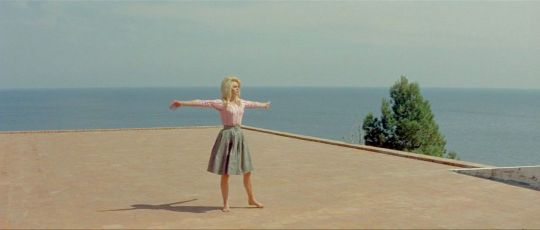
Brigitte Bardot in ‘Le Mepris’
Godard’s clean-cut directing & blunt writing style, along with the impressive acting are all successful in presenting a widely emotional drama. Set in the outstandingly beautiful Capri, melancholy and mourning is mixed with the sunlight and dreamy landscape of the island. As Godard worked with cinematographer Raoul Coutard, he contrasts light and dark, showing the unexpected nature of life - where love can grow in a beautiful area, it can also be killed. We associate colour and light with positivity, yet the fact is that however life changes, the world around us does still remain the same. This is reflected in the writing of the film, as Godard’s straightforward dialogue hits hard. Rather than creating a falsely dramatic ‘movie magic’ script, there is no drama in the very real & blunt adult conversation that characters’ Camille & Paul have in establishing their feelings for one another. As Paul questions as to why Camille has been acting so distant, she simply replies with, ‘it’s true. I don’t love you anymore’. Paul asks, ‘you still loved me yesterday?’ & Camille replies with ‘yes, very much. Now it’s over’. With statements along the way from Camille like ‘that’s life’, there is melancholy reality, which is beautifully French in comparison to the excessive, long-winded scenes we see in todays writings. Yet the film seeps in elegance through it’s script, as when any words are spoken, each is valuable. As Camille reflects on the breakdown of her marriage, she metaphorically states, ‘We used to live in a cloud of unawareness, in delicious complicity. Things happened with sudden wild, enchanted recklessness’. Character Prokosch brings statements like ‘I don't believe in modesty. I believe in pride! I believe in the pride of making good films’. Furthermore to this, it, again, is the realism that breaks our hearts through the masterful filmmaking. The acting in ‘Le Mepris’ is very real, as Godard had the actors improvise lines in the moment. When asked about this, he stated, ‘I need them, just as I need the pulse and colours of real settings for atmosphere and creation’. Godard’s focus on realism is great as it is something so sincere and authentic. He also rather fitted the character of Camille to Bardot herself, rather than having Bardot act as Camille. This too made for an authentic script, as Bardot’s supposed acting ability shone through, bluntly delivering bold lines & somewhat rising above the typical sensual blonde that she was used to playing, as she had a voice. Godard’s writing brings in slices of poetry to inspire us & add to the artistic nature of the cinematic experience.
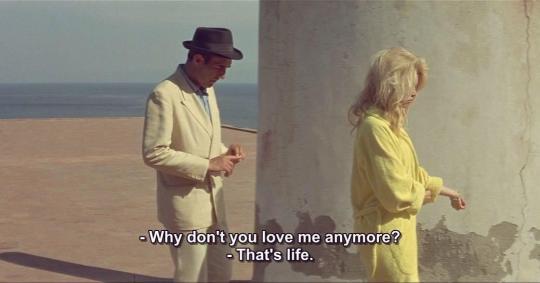
The Guardian’s description of it as ‘poetically sour’ encompasses the beauty of 1963 classic ‘Le Mepris’, as iconic director Jean-Luc Godard creates a heartbreakingly real tale of love lost. Through the recognisable New Wave style of the early 1960s that Godard helped define, the significance of ‘Le Mepris’ is made through it’s visuals and aesthetics, that we as an audience can recognise and appreciate. The beautifully artistic and European summer drama shines through with it’s ability to challenge everyday filmmaking. Godard hits the nail on the head with every emotion throughout, presented through not only dialogue, but the ravishing soundtrack, cinematography, set design and overall disposition. ‘Le Mepris’ remains a wonder that inspires and transports us to a world that, through it’s passion, seems all to familiar for some.
Stars Out of Five: 5/5
3 notes
·
View notes
Text
How Home is Home - Brooklyn Analysis & Review
John Crowley’s ‘Brooklyn’ encompasses some of the most heartening themes that, no doubt, tug at our heartstrings & successfully remind us of what home can look like. The period-drama strays far from being a dully classic romance picture, but bursts with warmth and fervour in one woman’s growth. Introducing us to a timid young Irish girl with a life changing opportunity upon moving to Brooklyn, New York, her story is shaped by her change in character and realisation of what home can become. A dynamic cast and beautiful writing deliver an incandescent coming of age story, bursting with life. We discover what a homeland means, and how one woman’s experiences drastically impact her.
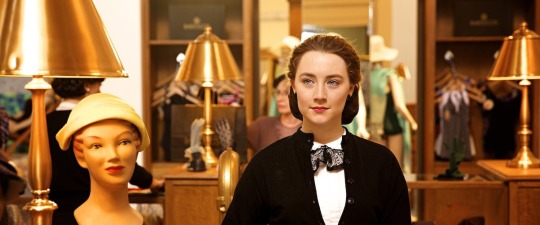
Saoirse Ronan in 'Brooklyn'
Set in 1950s Ireland & New York City, country girl Ellis’ dream is set in grandeur, but laced with pain in terms of one’s belonging. Uninterested with her conforming life in Ireland, Ellis Lacey is given the opportunity to start anew in Brooklyn, New York. What home can mean becomes a significant theme in the Irish immigrants change in heart. Upon first impressions, her social status does not settle into an American atmosphere, coming from a humble Wexford family. What characterises the idea of home is comfort, which is what Ellis was settling into before taking the step away from conformity. It is her timid nature that is challenged when working and studying in New York. Struggling to develop a community, she cannot get past her longing for her homeland. It is the belonging that is missing.

Saoirse Ronan & Domhnall Gleeson in 'Brooklyn'
As on Christmas Day, Ellis has nowhere to got but to the volunteer at a gathering for homeless Irishmen. Gathered around, a single man sings beckoning folksong, ‘Casadh An Tsúgáin’. Everpresent in cultural richness and striking misery, the heartache can be felt in the room, as Ellis struggles to cope with her rising homesickness. With a room full of men who have not returned to their home country in years, we can see the painful vulnerability of washed-up immigrants, Ellis included. These twisting emotions successfully show just how everpresent and fragile loneliness can be.
Ellis’ bouts of homesickness throughout the film are what add texture and reality to the story being told. Worrying about her future abroad when leaving Ireland, she seeks out the advice from the experienced Georgina, an Irish woman returning to Brooklyn. ‘How long do letters take to arrive from Ireland?’ she questions. ‘First, they take forever, but then, not as long’ Georgina answers. Arriving in new territory, her anxieties are cleverly written in a way that, show, rather than tell us about how she is coping. At her job in a department store, Ellis struggles to not feel homesick when serving customers, and on the streets of New York, she is alone. Sitting at the table with other Irish girls in her townhouse, she appears small and uncomfortable. Yet as she hears that news from home has arrived, she has leapt out of her seat. Reading the letters from her mother and sister, it is almost like she hasn’t seen them in years as she breaks down sobbing, clutching them to her chest. Clearly longing to have them with her, and not understanding why she moved away is all seen through the agony in her expression. This and the sweeping string soundtrack are written in a way to so effectively communicate the jagged emotions. The differing aesthetics of Ireland and New York too define the characteristics of what home can mean & how the change is vastly overwhelming for a young girl. Ireland is presented as a quaint, soft and green community, underlying home comforts there. Brooklyn, New York is shown in all it’s glory as an idealised city towering over Ellis with the loudness of the American dream shining on, post-WWII. Yet it is the way in which she moves on from the comforts of home and settles into a booming city that shows us her potential.

It is Ellis’ transformation that shows us however intimidating change can be, it is the one’s who take on the change that prosper. Handed a golden opportunity, her vulnerability is challenged greatly upon settling into an entirely new world. But, it is the way in which this is presented & written is what makes her transformation so grasping. Ellis leaves Ireland as a an introverted immigrant, tearfully waving her family goodbye without a word. Screenwriter Nick Hornby’s script cleverly focuses on the very actions that portray emotion, rather than long-winded dialogue to explain a character’s circumstances. Ellis’ apprehension upon leaving her hometown is spoken through her silence. There is no need for words to be said as a tearful Ellis blows a longing kiss to her mother and sister from to deck of the paced boat. The fearful expressions are enough to tug at our heartstrings. The struggles that are faced overseas are paramount for Ellis, one being that she loses her sister & cannot return home to grieve. Struggling to settle in, this is a painful dose of reality that she needs to cope with, showing audiences how unpredictable life can be, and that there is not always a protector, no matter where you are. Yet, it is how she overcomes it that strengthens her character, teaching us an important lesson in resilience in terms of your dreams being tested. The pang of regret for leaving is strong, yet the reward in fulfilling a dream is paramount. Soaring above hardships, priest Father Flood pulls Ellis aside in one scene, encompassing the change seen in Ellis by stating, ‘you’re not the miserable young girl who wanted to go home last winter.’

Saoirse Ronan & Emory Cohen in 'Brooklyn'
However, there was a great focus on romantic relationships defining what home meant for Ellis & how she only got through her homesickness through a partner. This is something I thought was only there to create interest and romanticise the story, but didn’t speak truthfully of what an immigrants’ experience may be. As she falls in love with Tony, the Italian plumber blessed with a thick New York accent, she seems to split her life in New York and Ireland by the men who are waiting for her there. In Ireland waits Jim Farrell, a charming and quiet footballer, who nearly convinces Ellis that her life could be great, provided she stay with him. A given is that this drama is set in the 1950s, so a woman’s marriage is deemed very important at the time. However much I appreciate a period drama, the idea that Ellis needed to be in love to overcome her personal struggles doesn’t speak too highly.
A greatly poignant scene that identifies Ellis’ transformation is the final sequence. A once timid and apprehensive young Irish girl stands on the bow of the ship, taking the place of the woman who on her first journey there gave her valuable guidance to start anew. Blossomed into a woman and donned with lipstick and a smart coat, Ellis tells the next girl making her way to Brooklyn of the values she’s discovered. A grand speech shows her change, focusing on homesickness and what home can be. Quote, ‘you’ll feel so homesick that you’ll want to die. And there’s nothing you can do about it, apart from endure it. But you will, and it won’t kill you.’ Ellis’ movement from innocence to experience is the most important theme throughout the film, as it focuses on what growing up is about - the importance of change.

John Crowley and Nick Hornby’s spirited adaptation of a classic period drama successfully strike a chord in the very heart of it’s audience. The soulful writing in this film communicate the depths of an emotion that each character experiences, focusing on feeling more than dialogue. Whatever amount of romantically dramatic you make it, the underlying message of finding ones place in our world is strongly there. The moments that showcase the bursting heart that ‘Brooklyn’ has to offer, both intimidate and embrace audiences with it’s simply inspiring tale-telling. With both heart and soul, the 2015 film is a remarkable feature, making a seemingly simple story into an original and great life lesson. However much belonging twists, ‘Brooklyn’ shows us that home is what you make it.
Stars Out of Five: 4/5
0 notes
Text
The Poignancy of Life Is Beautiful - Review
The phrase ‘tearjerker’ really is an understatement when remembering the absolute power that this piece of cinema holds.

Roberto Begnini & Nicoletta Braschi in 'Life Is Beautiful' (1997)
Roberto Benigni’s ‘La Vita e Bella’ (Life Is Beautiful) follows the stark contrast of life’s purest celebrations and greatest despairs over the course of seven years. Haunting and touching, it stars Benigni as ‘Guido’, an Italian waiter in the late 1930s. However ordinary his life may seem, it is the joy and humour that is paramount. The second half of the film follows Guido’s descent, as it is now the second world war, and as a Jew, Guido and his family are sent to a concentration camp. Yet Guido’s optimism for life never seems to end, as he turns the war into a game for him and his son. As romance and tragedy intertwine, this slice of history is somehow prevalent today, allowing us to reflect on the highest qualities and the worst misery in life.
‘La Vita è Bella’ really does live up to its title in the first half of the film, as director, co-writer, and star Begnini paints a colourful picture of a free and impassioned life. Yet, in the second half, the film’s name becomes an eerie echo of what used to be, it being a haunting hope from before, as well as deeply disturbing upon knowing the fate of the story. As beauty, Dora, literally falls into the arms of Guido from a barn, a usually manic Begnini exclaims, ‘buongiorno principessa!’. As the two run into each other over and over, Guido’s infatuation turns into unconditional love. Right in the middle of the Second World War, Guido and Dora have a son and have started a beautiful life. Forever changed is Guido’s dazzling existence when he is sent away to a concentration camp, with his family following.

To protect his son from the true horrors of the Holocaust, he uses his expert humour and imagination to craft their experience into a game, with first prize being a tank.
The separation between the joyous and depressing sides of this film are characterised in many ways. Guido’s fairytale life is filled with beauty, as we see his home decorated with curious antique furnishings. He too works at fanciful parties in a hotel, and on Sunday nights he attends ravishing shows at the theatre. He is free to make his life as fun as it can be. Yet, the twist of fate comes when he and his family are involved in the Holocaust; whisked away to a concentration camp. Dora’s rich, red dresses turn into dull striped pyjamas, and Guido’s characterful, antique-filled home turns into a cold wooden bunk bed.
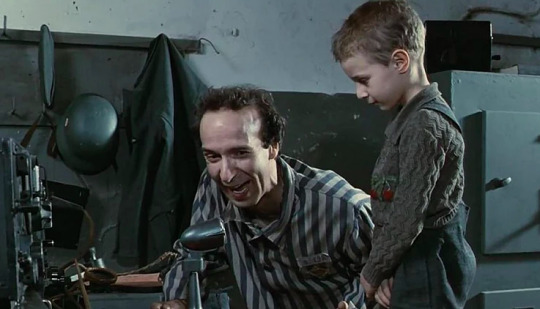
Roberto Begnini & Giorgio Cantarini in 'Life Is Beautiful' (1997)
As stark a contrast between love and hate there is throughout the film, Guido and Dora’s beautifully romantic relationship can be seen as light amongst the chaos. That love prevails, romance is timeless, and it is for certain that “life is beautiful”. When winning the Oscar for Best Foreign Language Film, Begnini closed his speech by quoting Dante, stating that, in making the film, he was impacted by “the love that moves the sun and all the stars”. The first half of the film is a pure celebration of the greatest aspects of humanity and a beautiful life, with the second half showcasing the very worst aspects of humanity.
To choose such a grim area of history allows Begnini to strongly juxtapose both light and darkness, as well as delivering a strong political message and inspiring lesson on the human condition. In an interview with The Guardian, Begnini spoke on the movie, defending its controversial take, stating:
“to laugh and to cry comes from the same point of the soul, no? I'm a storyteller: the crux of the matter is to reach beauty, poetry, it doesn't matter if that is comedy or tragedy. They're the same if you reach the beauty."
Many can take this point in reference to the movie as a controversial statement, given the history it focuses on. As Guido acts all through the holocaust to protect his son, this can either be seen as an act of bravery or foolishly bad parenting, dividing opinions on the movie. For example, one may detest the film as Guido lies to his son about the reality of what they are facing, whereas one may adore Guido’s high spirits and ways in which he keeps his son safe. Film critic Tom Dawson spoke on the film, stating that “the film is presumably intended as a tribute to the powers of imagination, innocence, and love in the most harrowing circumstances.” The point of the human condition that Begnini so cleverly focuses on is that throughout life’s heaviest sorrows, nevertheless, we are led to see which always wins - love.
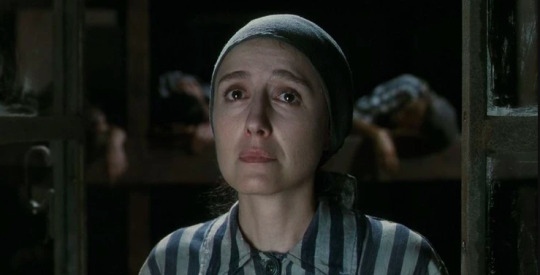
Nicoletta Braschi in 'Life Is Beautiful' (1997)
Roberto Begnini’s life philosophy is one of a carefree nature and the beloved film he has created is personable to his own life. Writing the screenplay with Vincenzo Cerami, the film’s inspiration comes from the book 'In The End, I Beat Hitler', written by Rubino Romeo Salmoni, heavily focusing on black comedy. Begnini’s father explained his time working at a Nazi Labour camp in a humorous manner to his children, lightening the weight of the reality. Furthermore, Begnini’s co-star Nicoletta Braschi, who plays ‘Dora’, really is his wife in reality. These aspects of Begnini’s life, philosophies and inspirations all rolled into one make the cinematic experience all the more meaningful.

Roberto Begnini’s exquisite must-watch ‘life is beautiful’ encompasses the highest and lowest points imaginable. So cleverly contrasting love and hate, it is a purely poignant and striking lesson on the human condition. Begnini's film continues to remind us of the great beauty and suffering that comes with being alive. The phrase ‘tearjerker’ really is an understatement when remembering the absolute power that this piece of cinema holds.
Stars Out of Five: 4.5/5
1 note
·
View note
Photo
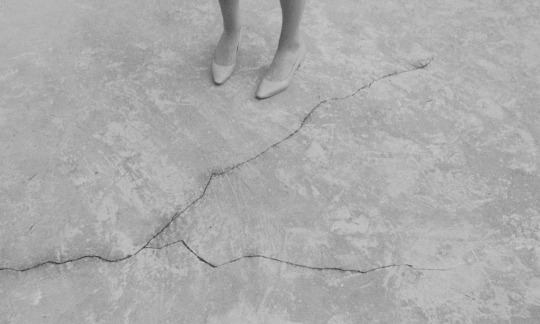
Repulsion (Roman Polanski, 1965)
*Cinematic Studies is also on Instagram. Follow @cinematicstudies
155 notes
·
View notes